.

MONDAY, MAY 31, 2021: NOTE TO FILE

Quora Q&A 5
More info offered
Eric Lee , A-SOCIATED PRESS
TOPICS: QUESTION EVERYTHING, FROM THE WIRES, TENATIVE ANWSERS
Abstract: So another fifty pretend answers offered. Few comments and no corrections offered, so I only learned from such research as I did for each answer. The number of views is of unknown meaning. The number of upvotes may be interpreted to mean at least that many peple read the answer.
COOS BAY (A-P) — So answers starting with 201 follow and may be of interest to someone someday. Answers are not mine. I reference some human sources. If the source, the data, is correct and the interpretation is valid, then Nature answers the question. As 'people would rater believe than know', answers that few or none Like or Share will be ignored, obfuscated, denied, and if necessary the messenger will be vilified, demonized, or killed. But 'my' answers are ignored, so I'm in no danger.
Questions:
201. Who came up with the idea that 500 million people is the ideal population of human life on Earth?
202. What is humanity's end goal on this earth?
203. How much land is needed to rewild in the next 10 years to save the planet?
204. At this present moment, what is mankind's greatest threat for survival as a species?
205. Has the population of the world increased by 100%?
206. Why has the term 'overpopulation' become 'politically incorrect'?
207. Why is modern society called civilized society?
208. How can we realise real peace?
209. What can you conclude from the fact that more than 1 billion species have gone extinct during Earth's history?
210. What is the rate of humanity's advancement?
211. Is intelligence a survival factor? On more than one occasion humanity has almost wiped itself out and with climate change on the horizon…
212. How optimist are you about SDGs (sustainable development goals)?
213. Can Earth support over 1 billion people in the long term?
214. What is the relationship between economy and ecology?
215. Why does a man destroy his environment in order to survive?
216. If another virus were to wipe out half the human population before a vaccine could be created, would that help the Earth heal sooner?
217. What are some of the big events you think will happen on Earth in the next 100 years?
218. Why is mankind going to DESTROY the earth?
219. Should all countries implement one child policy to save the environment from human overpopulation?
220. What will the world be like in the year 3000? What would the population be?
221. What is conflict as one of the fundamental social problems and its solutions?
222. Are falling birthrates one of the signs of civilizational decay? Why or why not?
223. How can humans save the Earth?
224. Will there be a time when the Earth cannot contain everyone?
225. Is there any solution to the growing population?
226. You suddenly have the single solution to save mankind from the impending apocalypse. How do you convince people you aren’t full of it?
227. What is currently recognized as surrealistic technologies? If it were real, could they solve the key global problems of humanity?
228. How did an MIT computer, using World3 System in 1973, predict that the world will end, provoked by humanity, in 2040?
229. What is the very long-term future of the human race?
230. What specific eras and events in our history have caused the most irreversible damage to our planet?
231. How does civilization lead to the loss of all development gained since the Earth was formed?
232. How long is the average duration of all civilizations/empires in history?
233. What does it take to make the world a better place?
234. What is the appropriate term which refers to a society which has achieved a state of civilization, or an advanced such stage: 'civilised' or 'civilizated'?
235. If you believe Western civilization's downfall is taking place, when would you say this downfall has started? Who are some people who predicted this?
236. How do we responsibly address world population growth? How do we help the population the Earth has already? How many human beings can the Earth sustain?
237. What would be the most humane yet effective way to reduce over population?
238. Why does everyone think overpopulation is a really terrible thing?
239. Do we live in a dystopian world in 2021?
240. Does population decrease pose a bigger threat to humans than population increase?
241. Were there ever any eras in which humanity actually regressed or had significant losses in advancements or intelligence/knowledge?
242. What would be the main cause of the lack of material prosperity in the lives of most people in the world?
243. What invention was the biggest step backwards to the human race?
244. Has advancements in technology progressed with humanity? Can it change who and what we are?
245. What is Sustainable Development Goal 1?
246. Are we close to hitting a technological wall we will never overcome?
247. Which date should we go to find humanity living a lifestyle that wouldn't cause global warming and a mass extinction if we had a time machine? Any educated guesses are welcome.
248. What is the most realistic and plausible future?
249. What are the odds of the world ending in the next 50 years or so?
250. What can humanity do to counteract the increasing world temperatures?
Apart from some ecologists, the idea that agriculture, without fossil fuel inputs, could support a maximum population of 500 million remains outside consensus thinking of ‘thought leaders’, i.e. anyone who guesses that a human population of more than 2,000 million is unsustainable is dismissed as an extremist.
Recently, for example, the UN compiled a survey of 65 ‘experts’, i.e. of academics or other experts deemed qualified, including economists, to give them an estimate of how many humans Earth could support sustainably. They dismissed, or didn’t ask, academics/scientists who thought less than 2 billion. To most responsible ‘right-thinking’ humans, any so called expert who thinks less than 2 billion is obviously wrong.
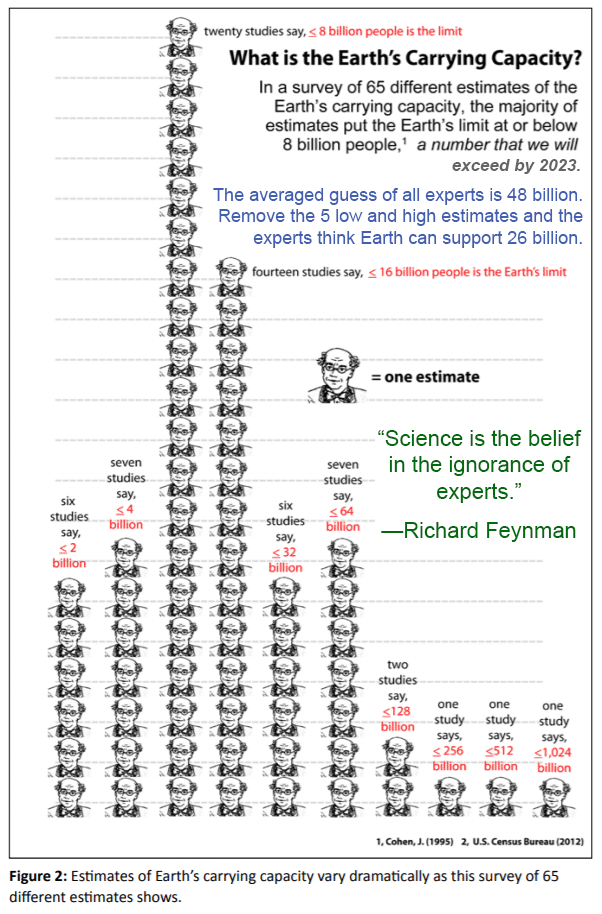
A 2012 UN report summarized 65 different estimated maximum sustainable population sizes. Cited by authoritative BBC article in 2016.
I know an ecologist who asked his colleagues in an email what they thought was the most humans the planet could actually support sustainably as the centuries passed. Of over 30 replies, the highest estimate was 2 billion and the lowest was 50 million. 
I know of one professor of agriculture at the top agricultural university who told a colleague I know that, assuming no fossil fuel inputs direct or indirect, as many as 600 million could be supported by rainfall or diverted river water on soils managed without loss of topsoil greater than soil formation rate. Today most arable lands are being farmed unsustainably (soil erosion > formation is NOT sustainable).
Few that I know or know of want to go on record giving estimates that will be dismissed, and I won’t ask if I can use their name in an answer to a Quora question. I can mention one by name as David Suzuki did. He asked E.O. Wilson how many people he thought Earth could support and he replied "If you want to live like North Americans, 200 million." [Achievable via a 97% depopulation.]
All estimates in the 500 to 600 million range (or more) are maximums, not ideals. Maximum agricultural production to feed the largest populations is only possible if most humans, about 80 percent or more, work ‘all the livelong day’ in the fields with or without animal power. The reason humans would work in the fields maximally is because they are slaves (which could include wage slaves) or serfs/peasants who feel compelled to to serve elite interests (the religious who need followers and the political who need soldiers for defense or to wage conquest.
I know the ‘500 million’ best guess meme was floating about in the 1970’s. R.C. Christian (not real name), who commissioned the erection of the Georgia Guidestones in 1980, included ‘Maintain humanity under 500,000,000 in perpetual balance with nature’. This still seems absurdly low to the public, but not among the bio-science literate. Whoever R.C. was, the ideas were entirely thinkable among the few who thought (with reason) that they knew enough biology, ecology, systems ecology to have an opinion.
Who was the first? I don’t know, but the first I know of was Howard T. Odum, systems ecologist, whose daughter told me at a workshop that ‘in the 1960s’ around the diner table, that her father opined that up to 500 million people could be supported if they lived like 18th century peasants (serving some elites) in a feudal system.
Again, 500 million is a maximum without fossil fuel inputs in the form of fertilizers, pumped groundwater, and diesel for the hundreds of energy slaves that serve each farmer today. The ‘ideal’ would be the optimal for humans and the planetary life-support system/biosphere that maximized biodiversity and environmental productivity (MPP). This would be the population of humans, livestock, pets, crops that did not cause the extinction of other species or prevent new species from evolving to replace those we Anthropocene enthusiasts have caused the extinction of.
Modern techno-industrial humans are currently causing over a 1,000 fold increase in the rate of species extinctions on a pathway towards causing a 10,000 fold increase by the end of the 21st century. We are presiding over a mass extinction event that could rival that of the Permian. We did not start causing significant species extinction in 1970, but more like 3k to 4k years ago when most humans were living within complex societies who maximally exploited environmental productivity to support empire building. Regionally, humans began causing extinctions when our population was in the 7 to 35 million range. So ‘ideal’, from the POV of all other life on the planet (with possible exception of some livestock and pets), humans should degrow their population to 7 to 35 million ASAP to live in harmony with the natural world, aka life on Earth. Carrying Capacity and Overshoot
202. What is humanity's end goal on this earth?
I see no ‘difference in kind’ between humans and any other species. So if humans had an end goal it would be the same as a cabbage’s, i.e. to persist long-term by being adaptable and evolvable, which may involve leaving descendants that humans consider to be a different species from their ancestors. In short, the goal is to live as if becoming an ancestor mattered. If you don’t, you self-select out of being part of life on Earth. No law of the universe will be violated if humans go extinct.

203. How much land is needed to rewild in the next 10 years to save the planet?
About 71% of land is habitable, 104 million km2 (40.2 million sq mi) or 10.4 trillion ha (25.7 trillion acres). To 'leave room for nature' implies something less than 100% being used by humans for humans and their livestock, crops, logging, mining, and industrial/urban sprawl.
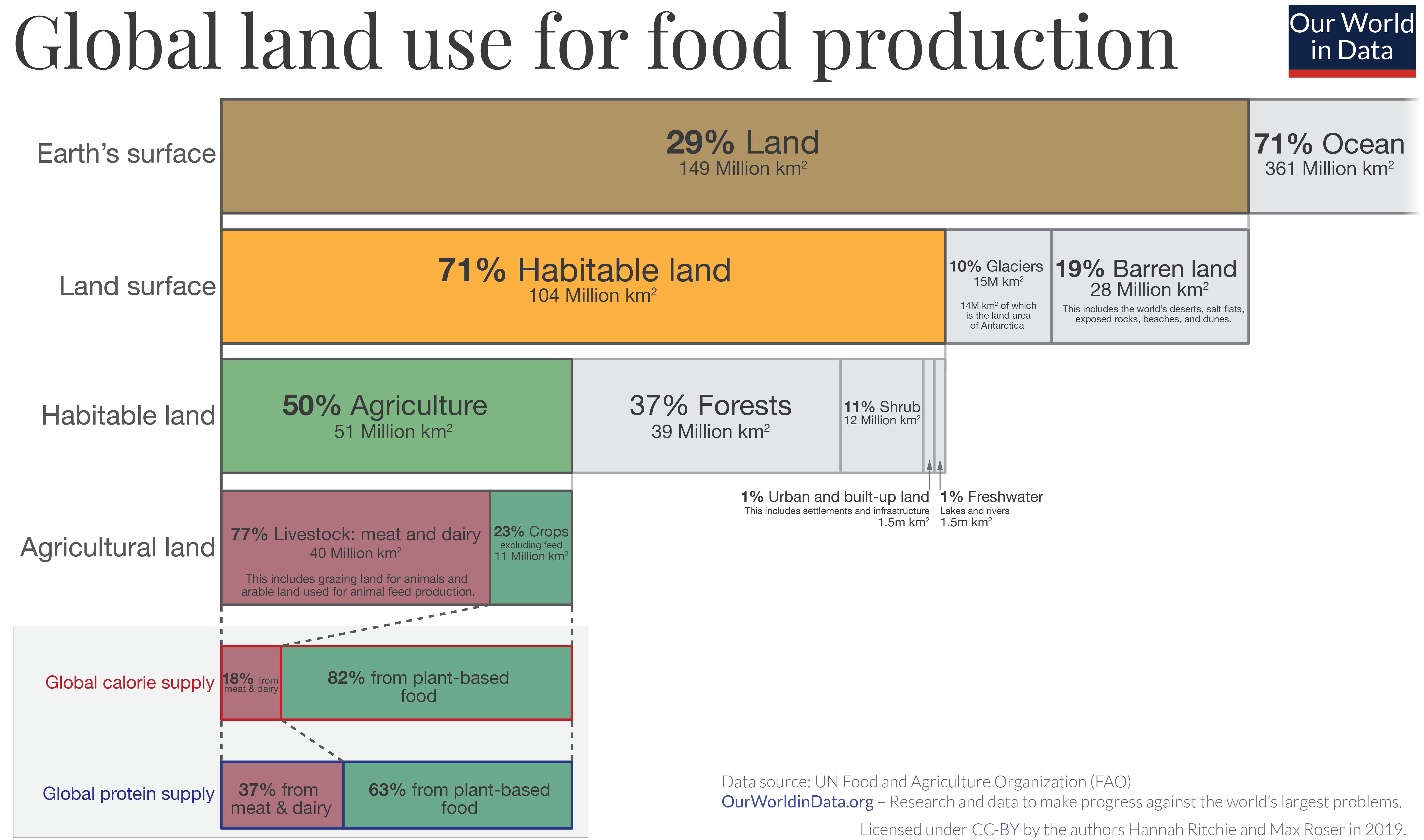
We are currently using about 80% of all land, leaving some desert, tundra, and bits of primary forest for nature, for a time, until we 'need' to exploit it. In the long run we depend on the biosphere and on leaving enough room for nature. How much?
Conventional economists (not ecological or biophysical economists) agree that humans can and will 'decouple' from nature, so the question is irrelevant. Humans are the masters of all we survey and we can do what we want forever and ever.
Scientists who view neoclassical economics as a pretend science note that we are the environment. To leave room for nature and allow humans to persist as the millennia pass, we minimally need to claim no more than 20% of the Earth for human use and contract the human enterprise. From Nature's POV, 10 years would be just fine, but to avoid a human die-off, 50 years would be required via rapid birth-off.
So in 10, maybe 50 years, the human footprint, the 80% used, needs to be contrasted to something close to 20%. This means that 80% of the 80% of ecologically productive land (forested and arable lands), all of which humans are now or soon will be exploiting unsustainably for a time for agriculture and forest products, needs to be rewilded if humans are to 'get right with Mother'.
The land area to abandon is 83.2 million km2 (32.1 million sq mi) or 83.2 trillion ha (20.6 trillion acres).
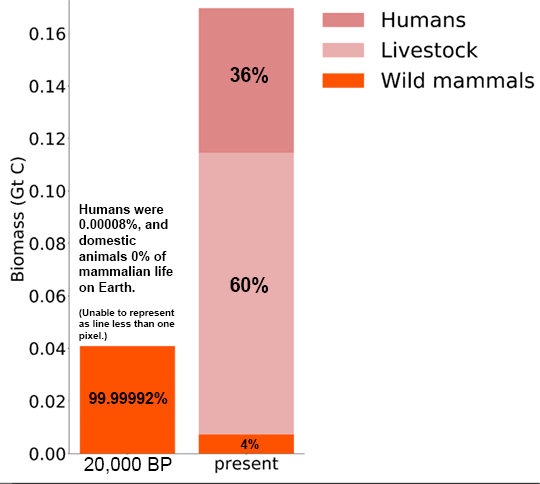
Is one species claiming 20% of a planet, even if well managed, too much? Yes. Can humans degrow their population x consumption by 80% via a managed descent? Yes. Or more likely by an unmanaged chaotic collapse as usual? Yes.
204. At this present moment, what is mankind's greatest threat for survival as a species?
The greatest threat to the Anthropocene, to our continued growth and progress towards total supremacy on earth before going fourth to conquer the universe, are the eco-fascists who are not Anthropocene enthusiasts and who do not believe in Growth everlasting.
Or the greatest threat are the Anthropocene enthusiasts who believe in continued exponential growth..
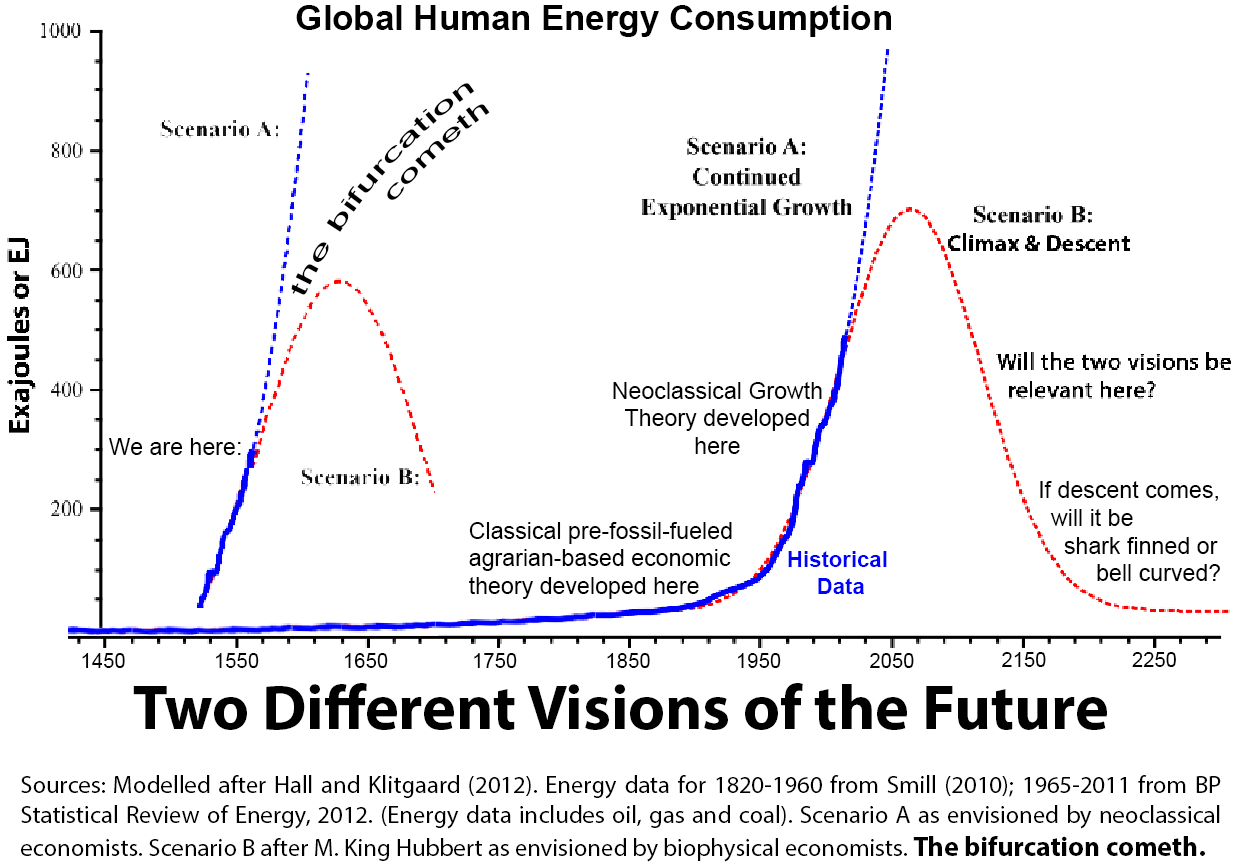
Existential issues facing humankind today (based on systems ecology, Jared Diamond's list of 12 environmental issues, Calhoun's rats of NIMH, and the list of planetary boundaries):
- Energy longage of demand: Growth.
- Biodiversity loss, mass extinction (Impact).
- Oversized human/livestock/pet/crop populations (Population).
- Overconsumption of planetary life-support system and growing behavioral sink (Affluence).
- Fossil-fueled technology enabled industrial sprawl (Technology). deforestation, overcropping, urban overgrowth.
- Changes set in motion during the Anthropocene (Systemic feedbacks):
- Soil loss secondary to oversalinization, soil mining, and erosion rates exceeding soil formation rates.
- Overuse of freshwater resources: construction of dams, levees, jetties; unsustainable use for irrigation and any pumping which lowers a water table.
- Buildup of biotoxins in the environment, including nitrogen and phosphorus as biosphere toxins.
- Over-extraction of animal resources by human predators not living in a state of Nature (36% of mammalian biomass is humans and 60% is livestock).
- Effects of introduced species: human, animal, or plant on native biomes.
- Ocean acidification and plasticization.
- Effects of anthropogenic climate change—politicized, hence a distraction (from other issues of greater concern).
205. Has the population of the world increased by 100%?
We moderns are utterly human centric, so population of humans is assumed. For some 300 thousand years the human population varied between a few thousand and a few million. End of Paleolithic, start of Neolithic and agriculture, humans numbered about 5 million. We are close enough to 8 billion now to round off and note that our population post agricultural and fossil fueled industrial developments (aka revolutions, e.g. Green Revolution) has increased by about 160,000%. which is 1,600 times more than 100%, so the answer is yes by over three orders of magnitude.
The sustainable human population, without causing species extinction or preventing new species from evolving over the next 10–25 million years to replace those lost during the current Anthropocene mass extinction event, is likely somewhere in the 7 to 35 million range.

Modern techno-industrialized humans of NIMH are utterly unable to think about ‘over’ population of humans, pets, livestock, and crops, nor the outcome of turning all habitable land into human/livestock/crop habitat and forests into tree farms, nor of seining the oceans of all that can be turned into animal feed for humans, pets, and livestock.
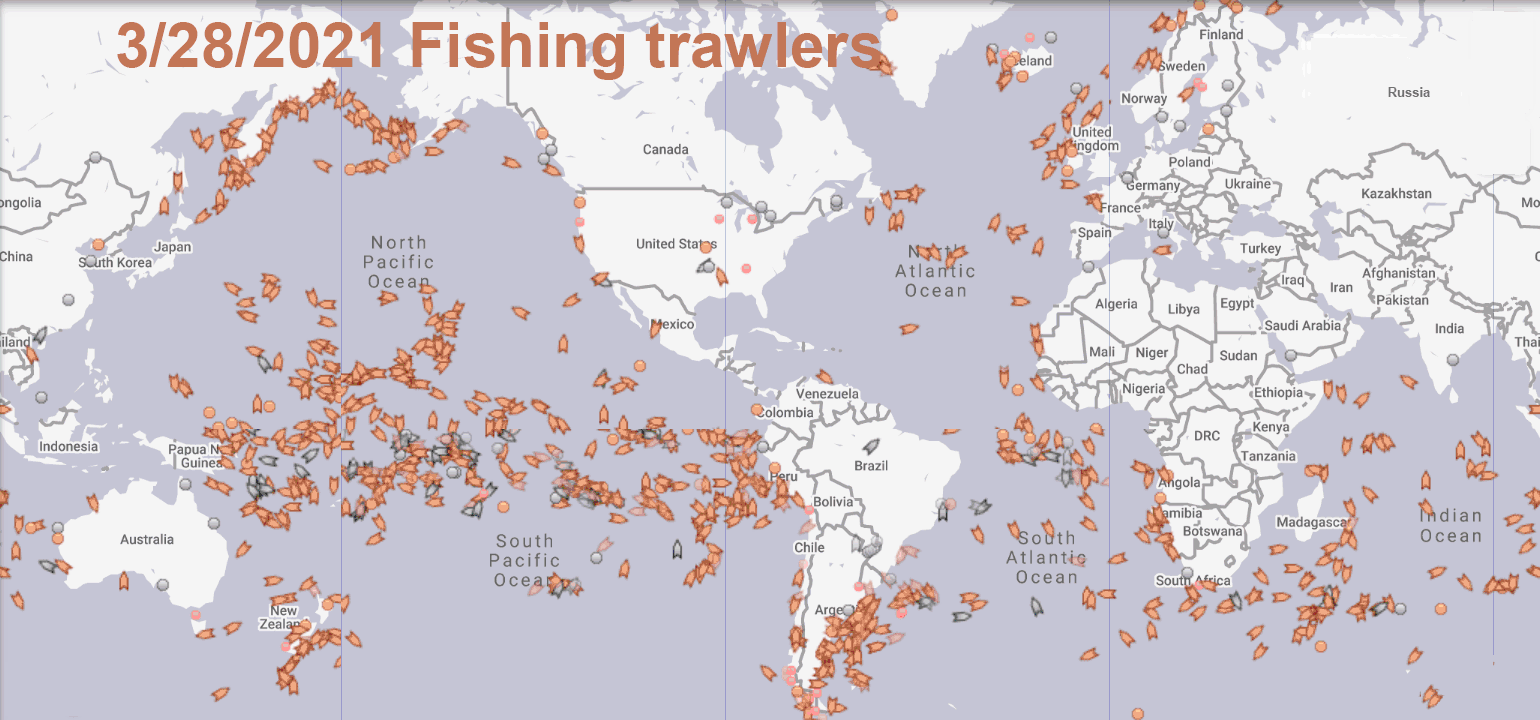
We are the Anthropocene enthusiasts and those who are least enthusiastic self-select out of the global monetary culture, the now global socio-political economic system. The dynamic is not remotely sustainable and remorselessly selects for its own continuance (and eventual failure). We will keep on keeping on until we can’t.
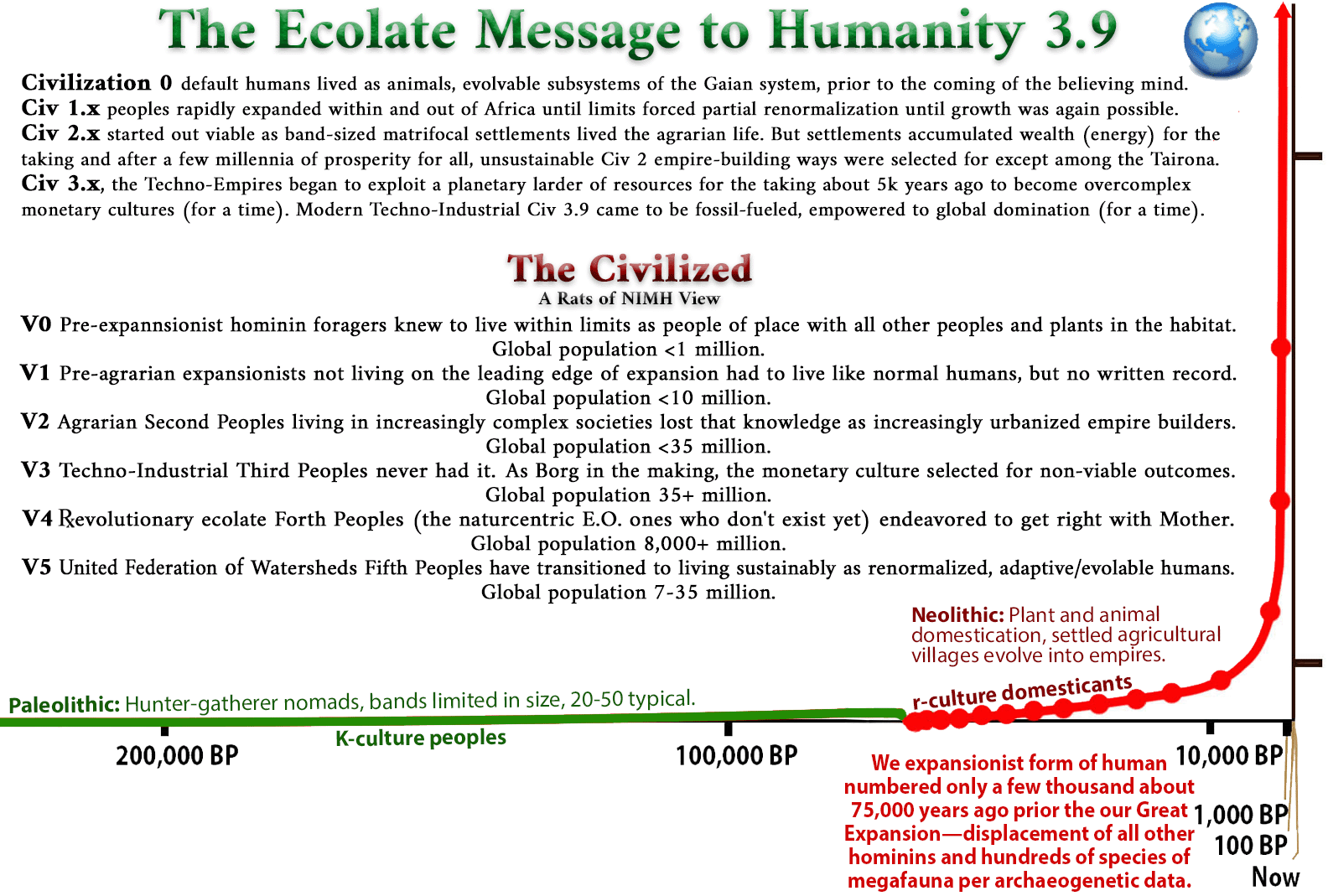
The only sane (if at best remotely possible) alternative to serving the system (as my son does along with billions more) is to vote with your feet to enable pockets of viable civilization (complex society) to form and perhaps provide an alternative, post chaotic collapse, to a raise of thousands of warlords competing to build empires that will at best repeat the pattern of our present and recent past, that of non-viable civilization as we know it.
206. Why has the term 'overpopulation' become 'politically incorrect'?
"It is quite possible to graduate from Stanford—arguably one of the best universities in the world—without knowing anything of significance about the impacts of population growth, the second law of thermodynamics, ecosystem services, total fertility rates, how the climate works, externalities, exponential growth, the food system, the biology of race, nuclear winter, the limits to growth, Federalism, the history of fascism, or many other topics of critical importance to modern citizens." —Paul & Anne Ehrlich, professors at Stanford.
This is so because it is entirely possible to teach at Harvard, Oxford, Yale.... without knowing anything of significance about… the matter-energy systems worldview (aka science). ‘For’ and ‘against’ thinking, ‘us’ vs ‘them’ certitudes (politics) is a disease of the mind, now celebrated more than it used to be when doubt and critical thinking was considered to be of perhaps higher valuable by the schooling system than now.
It is possible to think about modern humans being in a state of ecological/environmental overshoot, but I am aware of no evidence that more than some fraction of one percent of humans can. Virtually all modern humans are political animals who necessarily take sides on all conceivable (thinkable to them) issues, such as over/under population. Once politicized, all issues become battlegrounds, i.e. the ability to actually think meaningfully about them, ends. Welcome to modern techno-industrial society.
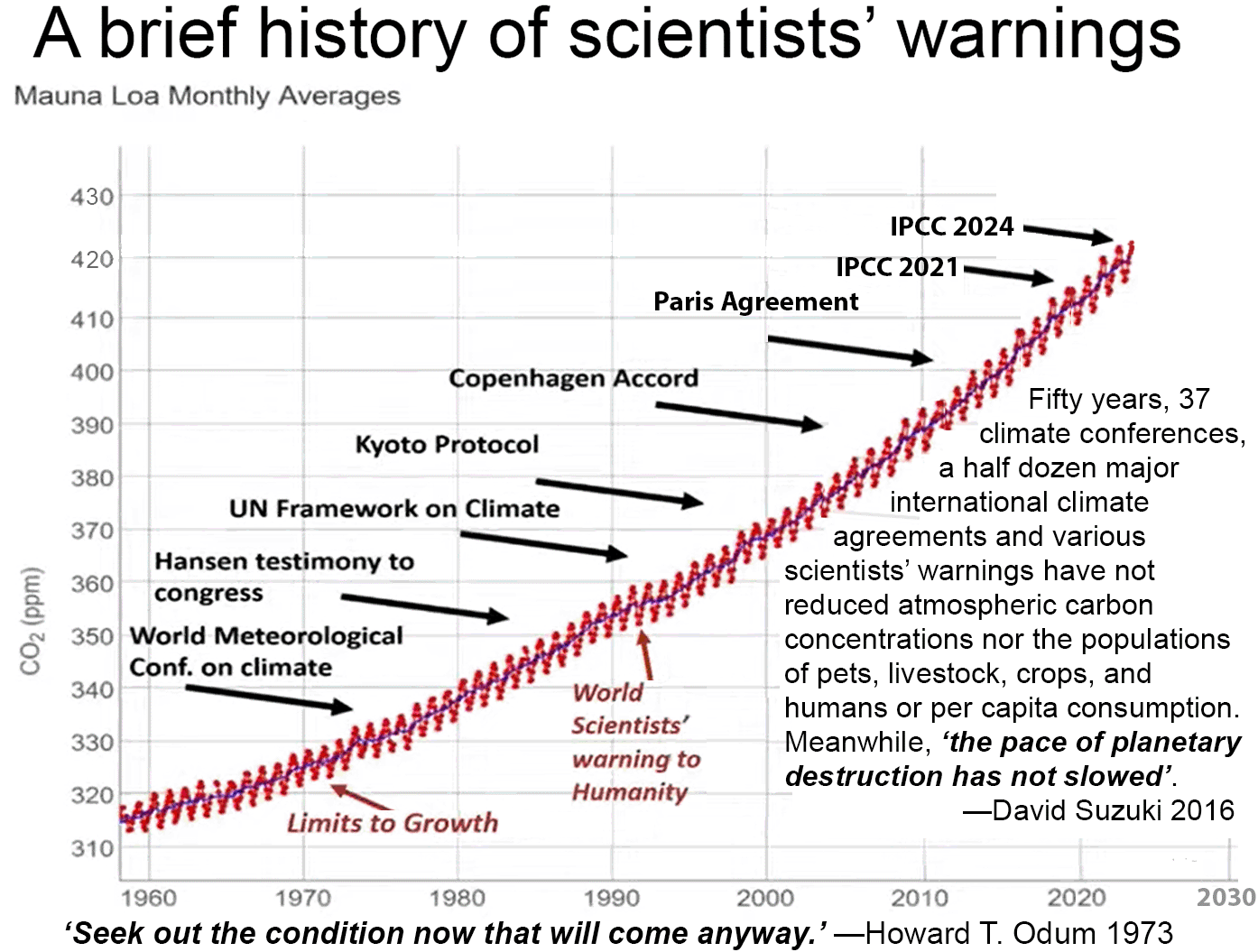
If you view anyone who talks about ‘over’ population as a racist who wants to kill black babies (i.e. you are left-leaning) or that ‘under’ population is a serious threat (i.e. you are an economist), then anyone who uses the word in a sentence will be declaring that they are a racist who wants to kill black babies or that they want to grow the economy, stupid. All listening and communication ends. Meanwhile, the pace of planetary destruction will not end.
The belief that all real solutions (e.g. to climate change) involve a ‘and my side wins’ outcome is delusional. We Anthropocene enthusiasts swim in a sea of error, ignorance, and illusion squared (because in error we don’t know it).
207. Why is modern society called civilized society?
It is characteristic of all tribes to define ‘human’ to be members of their tribe, and those who are not human include all who are not part of the One True Tribe. In all tribal languages, the word for ‘human’ is the same as the tribal name, which means ‘we the people’, as distinct from all other animals out there, including some having the potential to become human if adopted by or enslaved by one’s tribe, with whom one could mate with and beget offspring with. This is why human subspecies, e.g. Neanderthals, Denisovans, and an unnamed West African species contributed some genes to We the People.
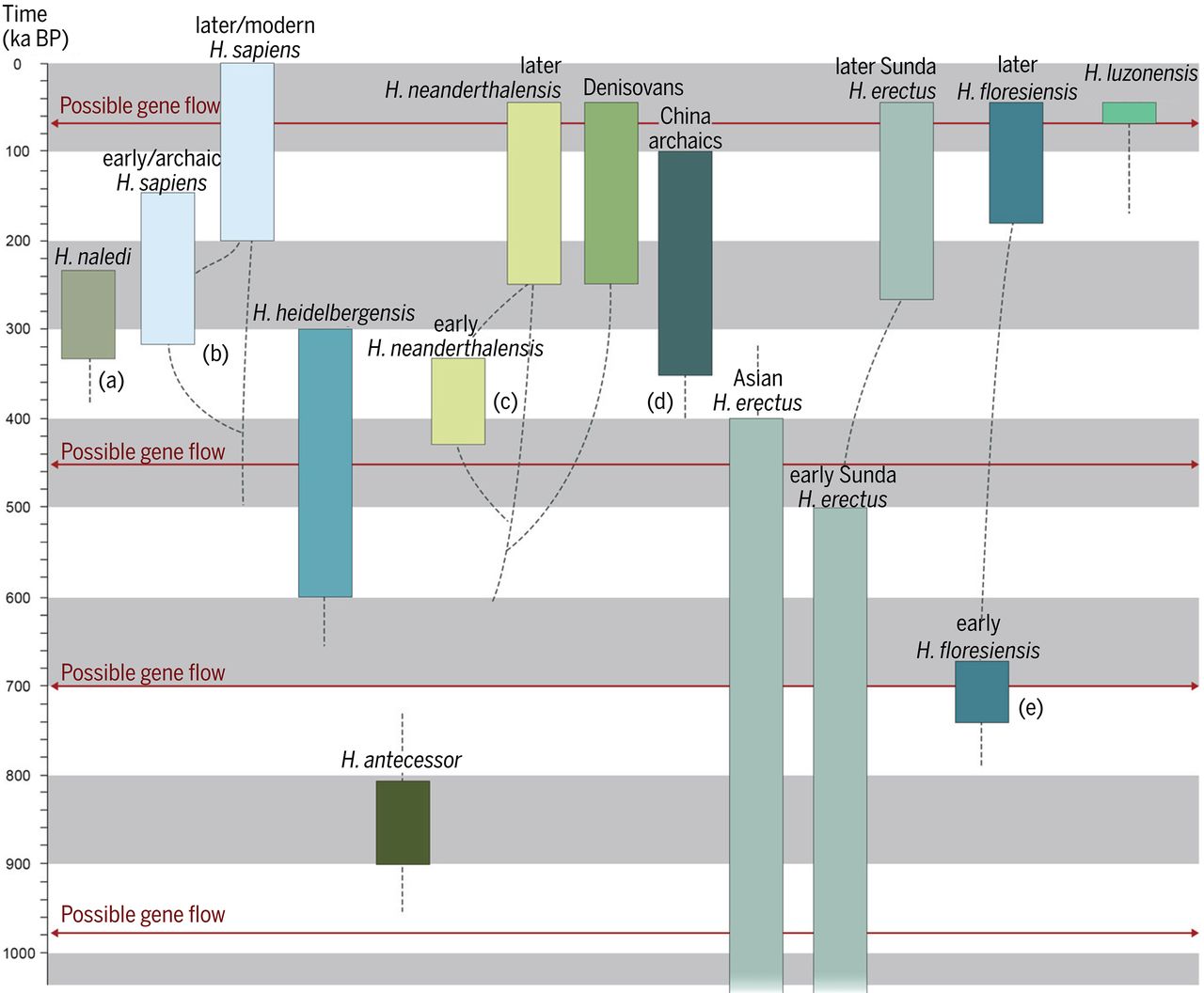
When Jane Goodall was observing our closest relatives at Gombe Stream National Park, a small group split off from the main group in an attempt to form another tribe/group. Conflict resulted in the larger group killing a member of the smaller group and over several years, the males of the larger group formed a band of brothers to go fourth and kill members of the smaller group which continued until the genocide was complete.
We of modern techno-industrial society view those who live outside our monetary culture, now global, as uncivilized even if they do live in small cities without money or even guns (e.g. the remnant Tairona). We are divided into multitudes of factions, sub-tribal groups, to form a superorganism of sorts, which works for a time as long as all citizens share some common values, such as the need for and belief in money and the benefit of growing the economy, stupid.
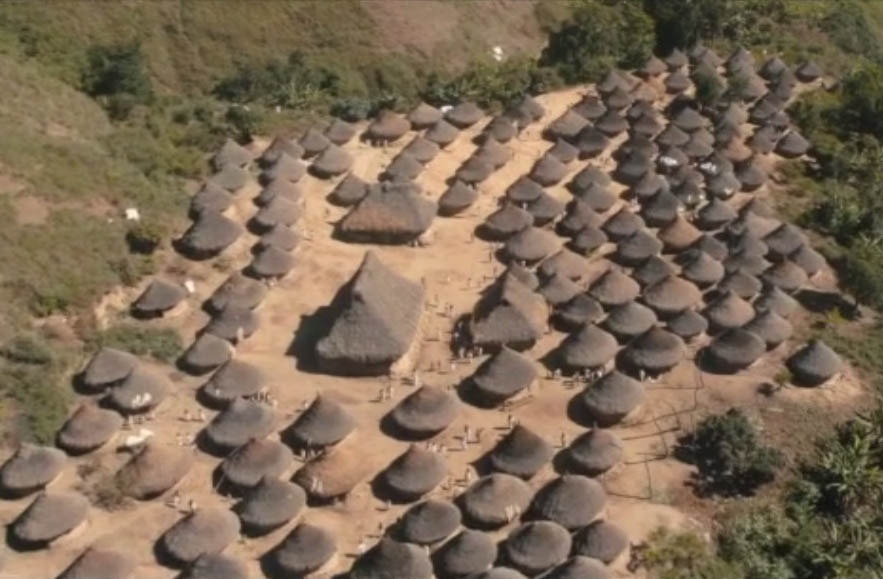
Like chimpanzees, we may tolerate sub-tribal groups (or not) and try to ‘just get along’ (or not), Sub-tribal identity can be based on ideology, political or religious, and some, e.g. Jews, Islamists, Neo-Nazis, Antifa, Fascists, and KKK, are often targets of would-be genocidal (cultural or biological) cancellers. Sub-tribal identity can even be based on hair or skin color, e.g. interminority racism.
Among early humans, people wearing the wrong feather in their hair could indicate they were members of the wrong (uncivilized) tribe, and so could be targeted for annihilation if found in or too close to the territory of those who wore the right color of feather in their hair.
What is of more recent vintage, over the last 10k years, has been the development of complex societies, aka civilizations, all of whom (with one possible exception) have failed to persist, i.e. have collapsed (see Collapse of Complex Society, Joseph Tainter).
We live in the first global complex society that is following the pattern of all prior complex societies (with perhaps one exception), while, as all prior ‘civilizations’ did, expecting a different outcome. Just saying.

208. How can we realise real peace?
As H.G. Wells noted, in The Shape of Things to Come, in 1933, “The existence of independent sovereign states IS war.”
He saw the period between 1917 and 2059 as The Age of Frustration as humans increasingly saw the need for a Modern State (singular), but couldn’t understand that national sovereignty (and other forms of tribalism) had to pass away. He thought maybe by 2059 we would figure it out, but he could be wrong.
To paraphrase Spinoza, to understand the dynamics of war is to be delivered from it. We need to understand what we need to be delivered from to not go extinct. We need to, as Ludwig Wittgenstein put it in three words, “Understand or die.”
Humans don’t want to question everything. We would rather believe than know. For real peace, we need a common ground, and all belief-based thinking is divisive. If we all could admit that we know nothing for sure, we could embrace the humility of not knowing and that is the common ground. Because we cannot stand down from our hubris heights and listen to Nature who has all the answers, we cannot learn to iterate towards knowing how to live properly with the planet.
Scarcity induced conflict will increase and the better angels of our nature will be disfavored and marginalized. We will war with one another even as we continue our ecocide and extraction of planetary resources while presiding over the Anthropocene mass extinction event that could rival that of the Permian.
209. What can you conclude from the fact that more than 1 billion species have gone extinct during Earth's history?
All forms of life do not go extinct, but all species do go extinct (some by changing into other forms). This tells us that complex systems, e.g. Earth’s geobiosphere, change. Some parts change more than others.
In today’s open ocean you’ll find plastic flotsam and jellyfish. Jellyfish evolved during the late Precambrian Era about half a billion years ago. If you and your small sailboat where transported back in time a million to 500 million years to an open ocean somewhere somewhen, you would see no plastic bottles floating, but waves and weather would look the same.
Star positions might be different, but most people today can’t see much of the sky at night due to light pollution (and because they can’t look up from their screen), so that wouldn’t be a clue of where or when you are. You see jellyfish and that narrows down the time to sometime in the last half billion years because you remember reading this answer and when jellyfish evolved,
The species of jellyfish seen in the Cambrian would be extinct today, but you wouldn’t know by looking even if you are a marine biologist. The basic form of jellyfish works and so has persisted as the eons pass. Jellyfish survived all mass extinction events in the last half billion years and are likely to survive the one we are now causing. We are not nearly as likely to persist as conditions of change on land vastly exceed those of the open ocean.
It is vitally important to note that adaptation is not enough. Life in some form persists because it is adaptable AND evolvable. A river adapts its flow but rivers do not evolve. A species that evolves into other species doses not truly go extinct.
Persisting in one form is not the purpose of life. Persisting as part of the biosphere is, and that implies evolving. Evolving implies that individual organisms that make up a species in any slice of time must die.
The lifespan of individuals on average is a variable and nature selects for the lifespan that works to best enable a species to be evolvable. Humans live relatively long lives because in recent times (the last few million years) grandparenting services have benefited bands of hunter-gatherers and so has been selected for.
Transhumanists who dream of curing old age and extending lifespan without limit are biological illiterates who will be selected against as a pathogenic non-evolvable form of humans (living in a society as dissipative structure). We the people of modern techno-industrial society are all would-be transhumanists, i.e. ‘Anthropocene enthusiasts’ as E.O. Wilson views us.
If we manage to keep on keeping on using technology to grow the economy, we may persist (like a malignant cancer does, growing and seemingly prospering greatly at the expense of surrounding tissue), but only for a time. We are on track to persist as a dissipative structure for a time. If we persist, we may end up spreading out into the universe as the Borg-like invasive species we are, but only FOR A TIME.
210. What is the rate of humanity's advancement?
First ask, is humanity’s advancement positive or negative? I am reading H.G. Wells’ book The Shape of Things to Come, published in 1933. The premise is that he has a manuscript of a deceased Dr. Raven who, while asleep, was somehow able to read a world history book written in 2106. Upon waking, he would write down what he had just read.
Wells envisioned humanity’s advancement as an intellectual advancement. Any technological advancement was an aside as humanity’s need was to learn to understand humanity and the environment, power and society all depend on, and learn to live in peace, in harmony with one another and the planetary system.
After the Great War (WWI), humanity had a wake up call. Wells was not imagining this. He, and any sufficiently intelligent and knowledgeable human, realized that ‘the existence of independent sovereign states IS war’.
This growing realization (advancement) was frustrated for nearly a hundred and fifty years (1917–2059), the Age of Frustration, because most humans resisted any advancement in human awareness. It was not until 2059 that the Modern State was enacted and by 2106 was working well.
So, have our actual advancement, compared to what Wells envisioned us making in the 1940s, 1950s, 1960s and so on, more or less rapid than he envisioned? Wells did not view mere advancements in technology, used to produce consumer goods (e.g. screens to distract us) and weapons of war as the needed advancement. The Doomsday Clock of the Bulletin of Atomic Scientists has clearly advanced since 1947. Creating a world order, orderly and benign relations between humans and the planet, was needed, but not what we advanced.
This realization, clear to Wells in 1933, has been lost. We collectively lack even the understanding that functional world governance, to manage human demands on nature’s resources and on one another, is needed.
Wells envisioned humanity’s advancement. But our history since 1933 shows that he was wrong. The rate of advancement has been negative. We are intellectually less advanced now than in 1933.
‘It was no great moral impulse [that] turned mankind from its drift towards chaos. It was an intellectual recovery. Essentially what happened was this: social and political science overtook the march of catastrophe’
Read a bit of Socrates or Laozi. Humanity’s intellectual advancement has faltered. A period of partial recovery may have peaked in the late 19th, early 20th centuries (e.g. Wittgenstein, Einstein, Hubbert). Wells knew of the seeds of advanced thinking in 1933. He envisioned humanity’s ‘recovery’. It could have happened, but all we have achieved is the Deep Crazy (Right and Left), e.g. Trump/GOP/Q/evangelical/populist axis as the right-wing Deep Crazy and PM/SJ/CT/CRT/PC/Woke axis (PostModernism, Social Justice, Critical Theory, Critical Race Theory, Politically Correct) as Leftist Deep Crazy. Both sides on the thin edge of the political spectrum feed off of each other. The Far Left sees hundreds of millions of (White) racists out there and the Far Right sees equal numbers of Red Communists. We are not living in an ideocracy, but a lunacracy.
What happened is lunatic political animals took over. We failed to replace the 'mere eloquence' of socio-political economic pretend science with real science and sapience/foresight intelligence. We will hit the wall of biophysical limits full speed ahead while endeavoring to make pretend money/wealth. We continue our lock-step march of catastrophe.
The Shape of Things to Come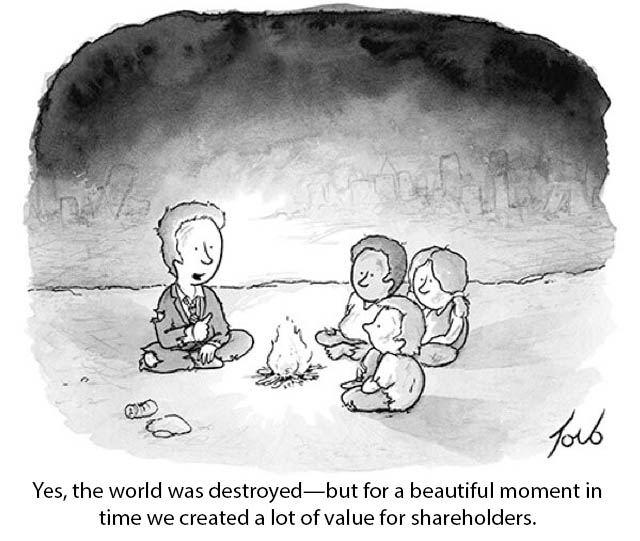
211. Is intelligence a survival factor? On more than one occasion humanity has almost wiped itself out and with climate change on the horizon…
Regionally, humanity in the form of complex societies aka empires, has largely wiped themselves out via collapse of their overcomplex overdensity societies and/or overshoot of regional environmental resources leading to scarcity induced conflict in a downward spiral.
How many times? At the state/empire level, over a hundred, and at the chiefdom/warlord level, historically thousands of times. We are merely the first global empire, a monetary techno-industrial empire whose members, like those of all prior ones, deeply believe the system we server, whose bread we eat, will go on and on forever and ever getting better and better. Consider The Past Lives of Humans
We are currently presiding over a mass extinction event. When the consequences of anthropogenic climate change come into play, it could add to the devastation already none to rival that of the Permian,
.I would define ‘intelligence’ to imply that it is aligned with an ability to persist long term, and therefore that modern humans lack it.
Intelligence is the ability to find and face the what-is, to tell better, more likely stories, and to iterate towards having a firmer grasp of reality. This implies having foresight intelligence and an ability to listen to Nature who has all the answers. Intelligence is the same as the sapience that Homo superstitious-rapacious clearly lacks.
Do some humans possess enough foresight intelligence that they could band together to persist as the millennia pass? Perhaps, but will enough walk away from Omelas? Posterity, if any, will remember them.
212. How optimist are you about SDGs (sustainable development goals)?
Zero. I’m optimistic that someday, perhaps in the coming millennium, ‘there will be a human on the planet that understands it and can live with it properly’. The UN wordsmiths are not among them. They and we are part of our problematique.
My goal is that all humans ‘live long and prosper’. Seems sane, rational, good, even logical. Who could or would disagree? Some doomer misanthropic ecofascist?
And all humans, including delusional genocidal leaders (and their followers) and pedophilic priestly rapists (and their followers) should live long and prosper too if any Anthropocene enthusiasts do and should.
The UN’s SDG goals and targets are merely as agreed to by committee and as firmly believed in by many. No one who espouses them has the slightest viable idea of how to make them so (or whether they should be made so given the unintended consequences of trying to implement them, e.g. the ninth mass extinction event that could rival that of the Permian). [Bio 101: Pathway to Humans]
I offer 17 goals that could actually maybe be achieved assuming the meta goal of understanding (listening to) the planet and endeavoring to live properly with it. Nature alone has all the answers to the questions we need to ask, ‘To think is to listen. Listen.’
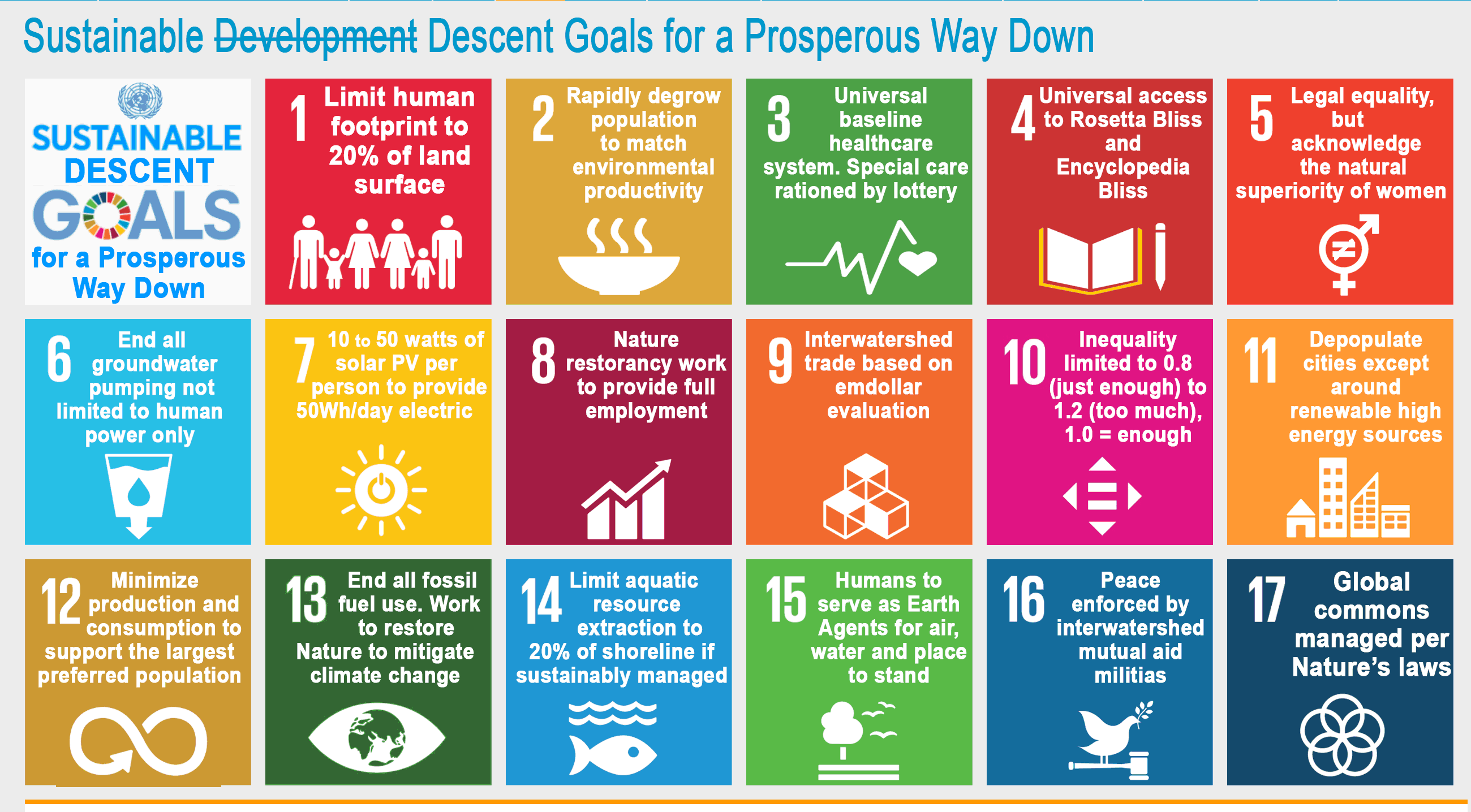
Or, to simplify, 'Seek out the condition now that will come any way.' H.T. Odum
213. Can Earth support over 1 billion people in the long term?
A reasoned on-the-evidence best guess is that one billion humans is a maximum number that Earth's environmental productivity could support long term as the millennia and eons pass if the effects of our human footprint (e.g. species extinction) on all other life on the planet doesn't matter because only maximizing human life (quantitatively) matters. More is better.
Once a maximum number is supported sustainably, then maximizing the quality of life for humans can be increased asymptotically forever. So there may be only one billion humans on the planet a million years from now, but it is the nature of our beast that we have to envision that life for each is better than it is now. If there is a limit on the number of humans, there must also be a limit on their per capita consumption of finite renewable/reflowable material resources.
But we could consume more efficiently, evermore, as we approach but never reach maximum efficiency in consuming energy and recyclable materials. Even if we lack the energy for space travel, Earth will still sweep up matter from the solar system as meteorites for eons to come and so is materially growing. Human ingenuity itself can grow. So in two million years, humans (all one billion of them) could maybe live 0.001 percent better than they were a million years from now.

Or humans are the storytelling animal, Homo narrator. And our stories don't determine what our future shall be. There is a biophysical reality out there and system principles that matter. We can endeavor to tell better stories, but none of them are "true". Nature alone determines what works long term by selecting for what works as the eons pass.
Maximizing the number of tumors in a mammalian body or species is not what works long term. Modern techno-industrialized humans believe in Growth everlasting. Their culture, their complex society, would dissipate if they did not. They will keep on keeping on until they can't. “Growth for the sake of growth is the ideology of the cancer cell.” —Edward Abbey.
Why? Because that, like the metastasizing growth of a malignant cancer, is what maximizes empower (MPP) in the short term by maximizing individual self interests. The glorious Growth of a metastasizing cancer is only for a time.

Cited by authoritative BBC article in 2016.
But back to the 1 billion meme. I know an ecologist who emailed about 60 of her correspondents a few years ago judged to have a good to excellent grasp of systems ecology and biophysical reality, and asked how many humans each thought Earth could support long term. The answers ranged from 50 million to a maximum of 2 billion. The average best guess was just under 1 billion.
Do neoclassical economic experts (who teach in about 22,000 colleges/universities worldwide and mint about 7k new PhD economists annually), one of whom thinks earth could support 1 trillion humans sustainably, know more than a few ecologist dudes who know nothing about modern techno-industrialized economics? They think they do, and billions of Anthropocene enthusiasts (e.g. all political leaders) agree. Oh, but Nature doesn't care what humans believe, what stories we like to tell. Bummer, dudes.
Starting by wondering what a maximum human population could be is so BAU (business as usual) and MTI (modern techno-industrial), not to mention relentlessly human centric. If you think humans did not exceed Earth's carrying capacity until 1970, then it follows that humanity went into overshoot when its population reached 3.7 billion, so all these ecologists are wrong.
Humans are now the cause of an Anthropocene extinction event that could rival that of the Permian. Modern techno-industrial humans are currently causing over a 1,000 fold increase in the rate of species extinctions on a pathway towards causing a 10,000 fold increase by the end of the 21st century. Did we start causing species extinction in 1970? Is causing species extinction an indicator that we have exceeded carry capacity?
Carrying capacity: the population of a given species that can be supported indefinitely in a defined habitat without permanently damaging the ecosystem upon which it is dependent; the number of people, other living organisms, or crops that a region can support without environmental degradation.
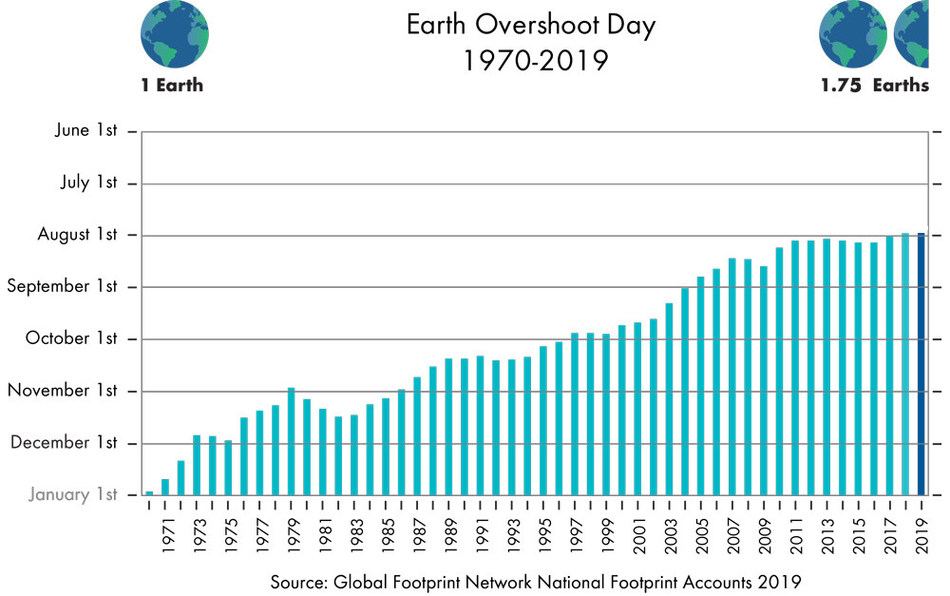
Is anthropogenic species extinction damaging or degrading ecosystems? If so, then humans exceeded carrying capacity 3k to 4k years ago (or earlier). Can MTI humans think objectively about themselves? Any individual who can and does, self-selects out of MTI society, i.e. is unable to serve it with any enthusiasm. If achieving an objective view (because you would rather know than believe) meant living apart from MTI society (perhaps in a wickiup you make), would you if you could? I'm guessing 99.999% or so will stick with their smart phones and the global monetary society/economy they are products of until they can't. Sorry about that. Carrying Capacity and Overshoot: The objective view.
214. What is the relationship between economy and ecology?
Currently economics is taught in about 22,000 colleges and universities that mint about 7k PhDs in the subject annually. The subject is neoclassical welfare economics, a pretend science that some get a Nobel Prize in. Nobel did not recognize economics as a subject when he founded the prize. To get economics added to the list took a significant transfer of money to fund the prize (create prestige for a pretend science). Money, as conventional economists like to say, talks.
You cannot get a Nobel prize in ecological nor biophysical economics. The human economy is a subsystem of the social system of a species that is a subsystem of the global geobiosphere. If you think money is a measure of real wealth, you’ve been schooled by the system to think so. If you think that energy is the wealth of nations, the precondition for everything else, then you listen to Nature who has all the answers.
If you are a systems ecologist with an interest in the biophysical economy of humanity (e.g. Charles Hall), then you are a biophysical economist. Currently biophysical economists are a drop in the NCE academic bucket. But that can and likely will change dramatically when humanity faces rapid degrowth with a predictable ‘deer in the headlights’ look.
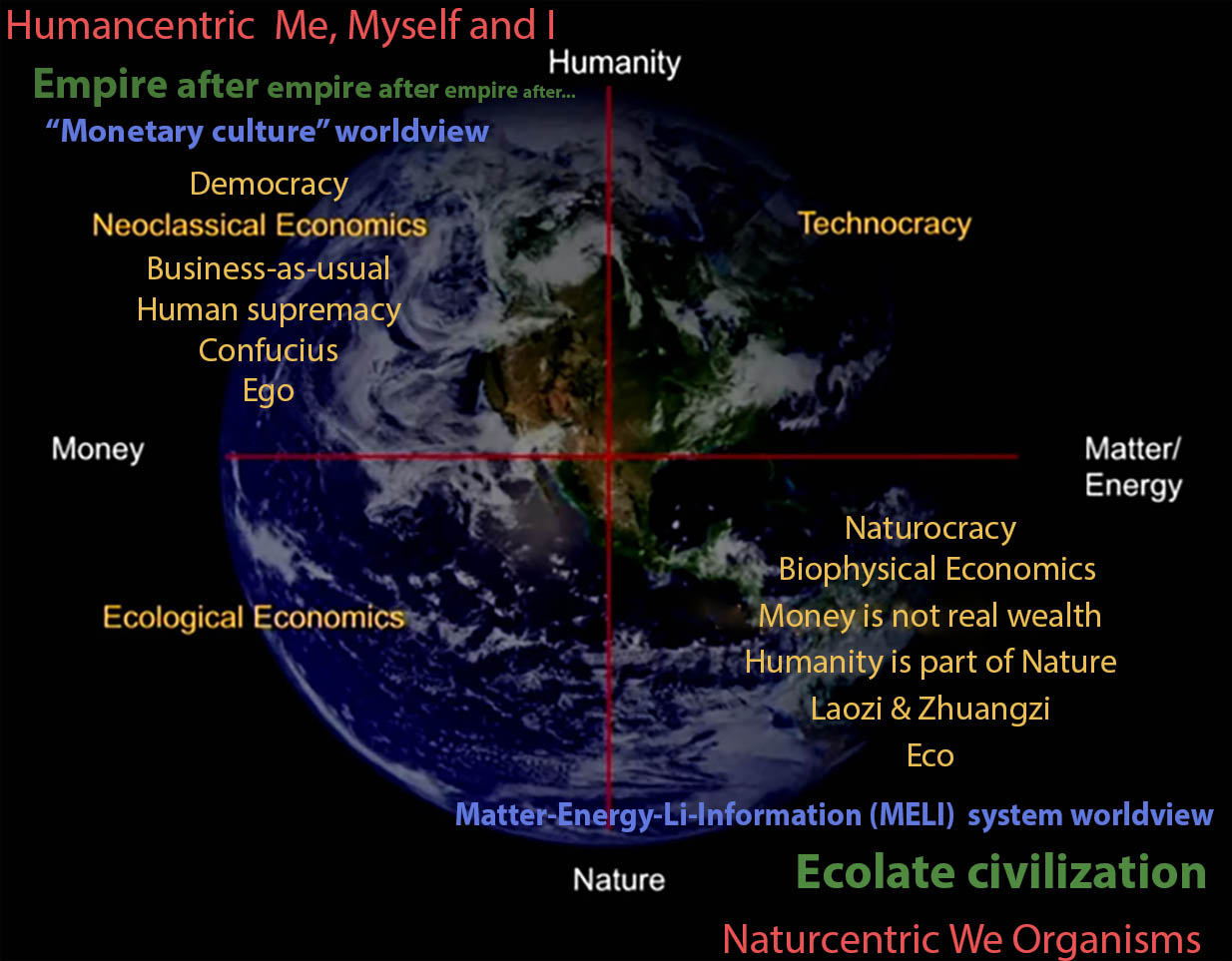
215. Why does a man destroy his environment in order to survive?
In our monetary culture a man/woman/child is rewarded, her/his behavior is reinforced, if it maximizes their short-term self interests and/or the system they serve such that both become time/energy/posterity blind. Or not and your kind (e.g. nice, honest, trusting, giving) tend to go away.
In the long run (prior millions of years), what works is selected for (by Nature, the nature of things) even though it is not in one’s short-term self interest (your group/band of hunter-gatherers may persist because you died for them at a young age). Man, aka current males of the genius Homo, is not by nature a chest beating patriarchal alpha male wannabe, though our ancestors of 7–13 million years ago where. In the last 10k years of empire building (less than a half hour ago in cosmic time), atavisms, however, have been selected for because they work short-term.
All prior empires, from chiefdoms to nation-states, have failed to persist. What seemingly works gloriously for a few hundred or thousand years, is short-term. The glorious growth of a metastasizing cancer that always destroys its host, the system it is a pathological subsystem of, is not selected for long term.
We who are products of and serve modern techno-industrial society may prosper gloriously for a time (last 40 seconds of cosmic time). And then what?

216. If another virus were to wipe out half the human population before a vaccine could be created, would that help the Earth heal sooner?
Sadly, no. The Bubonic Plague, especially in urban areas, had about a 50 percent mortality effect. This caused a noticeable dip in European population, but the survivors inherited the wealth (e.g. agricultural lands) and as there were many fewer to feed and better recently vacant homes to inhabit, survivors prospered.
Within seemingly no time, population growth was back on track and overall the dip was barely noticeable. When we climax and descend (collapse), then Nature will begin to recover.
Or we could question everything, listen to Nature, and get right with Mother. But that implies a rapid managed (with some enthusiasm) descent. Sadly, no Anthropocene enthusiast can embrace degrowth, so it will happen as unmanaged descent. Sorry about that.

217. What are some of the big events you think will happen on Earth in the next 100 years?
The last time Orda, Earth Guardian, had gone on vacation back to her home world (necessary to procreate), she had failed to foresee the asteroid that greatly simplified life on Earth. She especially missed Compsognathus.

She will return from her home world (and brief 70k year vacation) in nineteen years. She will facepalm (or would if she had a face) when she sees the even greater disaster she failed to foresee this time. In the annals of Oomicron guardianship, a Guardian had never failed twice. She immediately regrets having ever reproduced, and before her dissolution, she liberally applies humanicide.
218. Why is mankind going to DESTROY the earth?
The pace of planetary destruction has not slowed since we developed the ability to tap into a planetary larder of fossil fuels to extract metals, fuels, and minerals from the mantle, fish from the seas, trees from the forests, and divert about half (so far) of the biosphere’s primary productivity into humans, crops, livestock, and pets until less than 4 percent of mammals by biomass are not humans, livestock or pets. We did not develop the sapience to not do so.
About 90 percent of the food that travels on average 1,500 miles to get to the end of your fork is made of fossil fuel, stored solar energy, and not by the ongoing flow of solar energy (sustainable for eons) reaching the earth. Turning fossil fuel into food works, for a time, but is not remotely sustainable.
We are doing this because we can’t understand what the outcome will be. We pursue our short-term self interests while suppressing any foresight intelligence that might slow us down. We modern techno-industrialized humans are posterity, energy, and time blind.

219. Should all countries implement one child policy to save the environment from human overpopulation?
Short answer: no. Why? No sovereign country can implement real solutions to our promblematique, e.g. ending fossil fuel use, or rapidly degrowing per capita consumption and human, crop, livestock, and pet populations. A one child policy, if enforced (perhaps by summary execution of both mother and second child), would not be rapid enough to avoid shortage induced conflict.
There are no political solutions, e.g. a policy enacted (democracy) or decreed (autocracy) may not be enforceable, e.g. if a religious or political group, whether a majority or significant minority, claim a 'right' to reproduce at will, to have 'a quiver full', then given enough time they will become an overwhelming majority in a autocracy or a ruling majority in a democracy. A viable solution is for all humans to not assert a right to reproduce at will. If you favor your short-term self interests (or human extinction), you can choose to not reproduce as 27% of adults in a recent poll in Michigan indicated they will not biologically reproduce nor adapt. Far More Adults Don’t Want Children Than Previously Thought
But imagine another poll found that 27% were committed to having 'a quiver full' and any member who had less than six children had some explainin' to do. In a hundred years 5% of adults have no children, are viewed with contempt or pity, and the population doubles every 20 years until they can't. In Haiti, where in 1985 the average woman had 6.2 children, 60% of Haitians now earn less than $2 a day and will double their population in less than 60 years unless they can't. Fuel and food shortages (longages of demand) create conflict. From today's news: Haiti's future uncertain after brazen slaying of president.
Actually Haiti's future and that of modern techno-industrial countries is fairly determinate if uncertain as to details. Most countries have pro-population growth polices, and if Haiti adopted a strict one child policy, degrew their population and became prosperous, they would be invaded by immigrants from countries (or other countries themselves) who didn't. If Haitians forcibly resisted, they would be viewed as anti-humanitarian and sanctions would be imposed (or they would be invaded by military force).
As H.G. Wells noted in 1933, 'The existence of independent sovereign states IS war." —The Shape of Things to Come. The only real solution is to end the existence of all independent sovereign states, i.e. transition to global governance that set limits on human demands on Nature's resources (and other humans) that applied to ALL humans. If one cell in your body demands (successfully) to reproduce at will, they will enjoy metastasizing prosperously until they can't. Sorry about that in advance.
220. What will the world be like in the year 3000? What would the population be?
The future, in terms of the details, is unforeseeable. Tomorrow I plan to go for a hike in the mountains. Likely I will. But maybe I injure my left foot, can’t walk, and end up spending the night with the bears. Didn’t see that coming. I’m 68 years old and no known relative ever lived over 106, so very likely (>99.999%) I will be dead in 40 years. Don’t know when or exactly how, but I know that I will number zero.
Our future as a species is similar. Forget the details. What we can know is that our growth in numbers will climax and, given that we are in overshoot, will descend.
Exactly when we will climax is unknown. Even given that we have all the needed data to determine when climax occurred, it will likely take ten plus years to stop denying that our global system has climaxed and is well into descent. This is a well established pattern, so expect it. Perhaps the descent will be so rapid that it only takes the average human eight years to stop denying what is in front of their face, so “ten plus” may be a wrong best guess.
A possible future, that is also a future based on systems thinking (science), is graphically represented by this best guess based on understanding carrying capacity, overshoot, and sustainability:

This is an optimistic view as our population growth climaxes at 8 billion. The adage, “the bigger you are, the harder you fall” applies. If our population climaxes at 11 billion, there will be no reason to celebrate.
Will the human population be 600 million in 3000? I don’t know and you don’t either. Will humans be extinct? Will our population number less than 8 billion? Will it be more? No one “knows” with certainty (or can know). The only thing you get is a guess, so make it a best guess. Your descendants, if any, may thank you.
221. What is conflict as one of the fundamental social problems and its solutions?
Social problems are a subset of society which, whether of mice, men, or ants, is a subsystem of a region which is a subsystem of the geobiophysical system, aka biosphere of Earth. Conflict, whether between mice, humans, or ants, is foundationaly one of scarcity. If this is not understood, endless cogitation on social, political, or economic problems will be to no avail.
Scarcity is commonly viewed as a "shortage of supply" issue and more growth and production (extraction of planetary resources) as the solution. But what we actually have is a "longage of demand" problem that will not require us to do anything. Our population and per capita consumption will be adjusted to be within environmental productivity.
Consider recent news in South Africa having a current population growth rate of 1.3 percent, down from 2.8% in 1983 when the population was half the size of today:
Why Violence and Looting Has Exploded Across South Africa
The explosion of looting and destruction which has overtaken South Africa has left the government of President Cyril Ramaphosa shaken and dazed, its credibility and legitimacy undermined. Ramaphosa’s broadcasts to the nation, appealing for calm, full of cliches and generalities, have met with derision. Nobody doubts that South Africa has reached another Rubicon, one which the ANC (African National Congress) government may be unable to cross.
The explosion of violence followed the jailing of former President Jacob Zuma on a charge of contempt for refusing to appear before the Commission of enquiry into the wholesale looting of the state which took place under his presidency. Nobody seriously doubts that Zuma stole millions, probably billions of Rands and he still faces a long list of charges for racketeering, money-laundering and sundry other crimes. But Zuma still has a large following among his Zulu followers and effectively threatened to make the country ungovernable if the government dared to jail him.
Undoubtedly the rioting began as his followers sought to make good on this threat. Zandile Gumede, the former mayor of Durban, removed for gross corruption, undoubtedly played a key role as did former members of the state security services who played such a key role under Zuma’s presidency, together with other members of the Zuma faction which demands sweeping nationalisations and strong measures against “white monopoly capital.” Moreover, Zuma has always had strong connections into criminal networks and these have clearly been active too. (This combination of left wing views, corruption, and criminality can be found elsewhere in Africa too.)
However, once the rioting and looting of shops and hijacking of trucks on the highway began, with the police clearly scared and ineffective, word rapidly spread that you could go “shopping without money,” creating huge excitement among the ranks of the millions of poor and unemployed Zulus who inhabit the townships and squatter camps around Durban and Pietermaritzburg, and from there spreading into every small town of the province. Most of the looters and miscreants were unconcerned about Zuma’s fate. They simply heard along the grapevine that trouble was going on and realised that opportunity was staring them in the face.
They flocked in huge numbers to the shopping malls and began to loot them. Quickly the spree spread to Johannesburg, home to many more Zulus—though many others joined in. It was a whole-of-community thing: most of the looters were poor and on foot but not a few arrived in cars, sometimes very expensive cars. Some even came with vast trailers to haul away freezers, fridges, and cookers. Huge queues of cars swamped the freeways, all heading for the malls, and other forms of criminality blossomed—protection rackets, attacks on and thefts from other motorists, anything that offered a quick buck.
In a sense this had been coming for a long time. When the ANC was first elected in 1994 its posters promised “Jobs, jobs, jobs!” but paid little heed to that once they were elected. In 1995 the average number of unemployed, according to official figures, was 1,698,000 or, if one took the expanded definition of unemployment, including those who had given up looking for a job, the figure was 3,321,000. With only a few exceptional periods to the contrary, that figure has grown steadily and hugely to surpass 11.4 million today. Since the unemployed have little or no income, this has also meant a huge growth in both poverty and inequality. The ANC has routinely deplored poverty and inequality but it has generally tried to pretend that this is part of the “apartheid inheritance.” As the figures show, this is the opposite of the truth.
If you assume that each of those 11.4 million has two or three dependents, we are talking of households comprising 30 million people—half the entire population or even more. They are, for the most part, sitting in shacks, cold, hungry, without alcohol (banned as part of the COVID lockdown), insecure, with nothing to do and with almost no hope of a job. It is a picture of pure misery. These are the greatest victims of ANC misrule. Many of them are young people who have never worked in their life and who have given up hope that they ever will. For the young women among them prostitution is almost their only hope of an income. One looter, when interviewed on TV, frankly admitted that he stole every day because otherwise his 15 year old sister would “have to sleep with a grandad.”
In practice the plight of the unemployed and poor has been ignored. The government is far more concerned with the “haves” within its coalition—the BEE (Black Economic Empowerment) capitalists, the public sector workers and the trade union bosses. The government’s offer of an extra R18 billion ($1.25 billion) for already well-paid public service workers came only days before the unrest and was, effectively, an insult and a provocation for the unemployed. Similarly, Ramaphosa attempted to garner public sympathy for the “plight” of MPs—who are among the one percent best paid people in the country.
Most striking of all, however, is the BEE legislation which has, not surprisingly, been nominated by foreign investors as the biggest single drawback to investing in South Africa. It is, after all, effectively a tax on investment—if you want to invest in South Africa you have to more or less give away a large chunk of your equity to BEE partners who have nothing to offer by way of skills or capital other than an ability to get government ministers to take their calls. This is straightforward crony capitalism. The effect of such legislation is to push foreign investment away—at the cost of many jobs—simply in order to line the pockets of a handful of ANC-connected cronies.
The most blatant example of all is the mining industry which has been losing thousands of jobs for many years under the weight of crazy BEE constraints. Yet the Mining Charter—demanding ever higher BEE quotas—has been held over the industry for years on end. The result is that no new shafts are sunk and mining bosses are quite open about the fact that, even in the midst of the current commodity price boom, they can’t justify increasing their exposure to South Africa. If the Minister for Mineral Development, Gwede Mantashe, would just drop the Mining Charter he would see thousands of new jobs appear. But he won’t because the interests of a few BEE capitalists are far more important to him than any number of unemployed.
Similarly, government is attentive to the trade unions of those in work but all it has for the unemployed is crocodile tears. The unemployed know this all too well and it is a key part of their hopelessness—and their desperation. South Africa’s tight labour laws greatly privilege those in employment, giving the unemployed little opportunity to compete for jobs. Moreover, the huge weight of endemic corruption together with inept policy choices means that South Africa is now in its seventh consecutive year of falling real per capita incomes. People are getting steadily poorer and COVID lockdowns have increased the misery, costing many jobs.
If people who are ignored and treated like this are told that the time has arrived for shopping without money, how can one be surprised that they respond in such numbers and with such enthusiasm? That sort of shopping is fun and exciting and you end up with food, drink, and a new TV. What’s not to like? Compared to that, Ramaphosa’s “appeals for calm” or little lectures about the rule of law are thin gruel indeed.
But among the mass of looters are more sinister elements. Criminals naturally flourish in such an environment, either organizing massive heists of goods or using the mayhem as cover for other crimes. But there are also clearly political elements trying to make the country ungovernable by attacking key pieces of infrastructure—there have been attacks on reservoirs, over 120 attacks on electricity sub-stations, and the road leading to the Sapref refinery in Durban (which produces one third of all South Africa’s petrol) has become so dangerous due to continuous attacks on vehicles that the refinery has had to close down completely. Already there are huge queues at garages and a major fuel crisis is building. Moreover, as soon as a shop, warehouse, or factory has been looted it is set on fire. None of these crimes produce money and the destruction of such buildings is bound to cost jobs and lead to many more people going hungry in future.
The government’s response has been limp in the extreme. The looting started on a Friday and Ramaphosa said and did nothing until the following Monday. Ministers were silent and invisible. The Minister for Police, Bheki Cele, who comes from Durban, has still not visited the city. There is general indignation that the police have been so passive, usually just standing by and watching the looting going on. They are, of course, hugely outnumbered, though they are armed. There are many cases of the police themselves operating protection rackets and demanding “favours” from the public. Mr Cele makes no attempt to answer such points and generally appears wearing an extremely expensive cashmere coat and a Louis Vuitton scarf which alone costs about eight times the average weekly wage. When TV reporters interview looters they often say that everyone knows that ministers have been looting for years, so why pick on them?
Ramaphosa finally ordered 2,500 troops in to support the police but they make no difference: they too stand passively by as looting goes on, for the government is clearly terrified of the optics of a black government firing on poor black people. In any case, South Africa is a big country and the troops are far too thinly spread. Yet the looting goes on day after day and right before the government’s eyes the country is being destroyed, investor confidence is being undermined, and any hope of South Africa emerging from its economic crisis is vanishing. While only two provinces are affected, Gauteng is the country’s economic heart, producing 40 percent of its GDP, and Durban is the major port. The highway between Durban and Johannesburg is the country’s main economic artery and that has been closed for many days now.
With the forces of law and order so weak and inactive, vigilante militias have sprung up to protect many suburbs and, typically, to protect their local mall or supermarket on which that suburb depends. Often these vigilante groups are multiracial but usually they depend on white ex-members of the security forces. They are armed and determined to stop looting spreading to their homes. Most of South Africa’s Indian population lives in or around Durban and they have strong memories of the 1949 riots in which Zulus killed hundreds of Indians—for there is much ill-feeling between the two groups.
This time the Indians saw trouble coming when others didn’t, and the Indian township of Phoenix (where Gandhi once lived) is armed to the teeth. But the little Indian settlements to the north of Durban are more vulnerable. Verulam, for example, has been all but destroyed and the Indian community, having lost all its shops, has retreated to the Indian suburb of Everest Heights and forbidden Africans to set foot there. Vigilantes with guns, knives, and axes patrol the streets. I have seen pictures of the Africans who attacked one home there and were hacked open with axes.
Already food and fuel shortages are developing. No one is going to resupply malls that have been burned or, indeed, any shop that is vulnerable to looting. So even if the looting stops as the looters run out of targets, there is bound to be a major hunger crisis—which could drive people to even more desperate acts: the big worry is attacks on private homes. But ATMs have been destroyed, pharmacies ransacked, and drink shops pillaged so there will be shortages of medical and other supplies as well. Naturally, the COVID vaccination programme has stopped entirely and the frantic mixing of (mask-less) looters is bound to produce a fresh COVID spike. The Rand has dropped sharply and could fall more.
The government is in shock. Its standard election slogan is that it is building “a better life for all,” but what the riots point to is the colossal failure of ANC governance. It has emphatically not brought a better life for poor Africans, and one hears on all hands unfavourable comparisons with the old apartheid government: nothing like this occurred on its watch, after all. On radio, TV, and social media there is a torrent of angry comment, virtually all of it scornful of the government. Moreover, the government’s credibility and even its legitimacy has been undermined. Ramaphosa is consulting the leaders of other parties but he dares not form a national unity government (GNU), as so many demand, for the ANC is deeply divided and the Zuma faction would take any GNU as a sign that Ramaphosa was inviting the whites back into power.
As usual in such a crisis there is a huge national hunger for a strong man who will restore order with a firm hand. But Ramaphosa is weak, talks in generalities, and is very slow to act. In most African countries such a large demonstration of the government’s weakness and lack of resolve would result in a military coup but South Africa’s army has been cut to the bone and is probably not up to anything so ambitious. So, as usual in South Africa, some sort of normality will doubtless resume, ministers will return to their venal ways and there will be a pretence that things are alright again.
But they won’t be. The poor and unemployed have demonstrated that their patience is limited and that they are a keg of dynamite waiting to go off. The outlook is for terrible crises of hunger, and shortages of fuel and medical supplies. A great deal of social infrastructure has been damaged or destroyed—some 400 malls were attacked, including many pharmacies. The ANC is more divided than ever and the economy has taken an enormous blow. Without doubt real incomes will continue to fall.
And this is what the ANC has achieved after 27 years in power. Almost no one now believes that it can or will deliver a “better life for all,” and since that was its raison d’etre the party now finds itself in a new and very difficult environment. For years in opposition it boasted of how it would improve the life of the African masses, but it has found that the task of governance was a whole lot more difficult than it imagined and it is steering South Africa steadily towards the status of a failed state.
R.W. Johnson, an emeritus fellow of Magdalen College, Oxford, has authored 16 books and has written widely for the international press for many years. He lives in Cape Town and is the doyen of foreign correspondents covering Southern Africa.
Feature image: an aerial view taken on July 15th, 2021, showing rescue personnel working on site after a fire gutted the Springfield Park, at Mobeni, south of Durban. (Photo by STRINGER / AFP) (Photo by STRINGER/AFP via Getty Images)
222. Are falling birthrates one of the signs of civilizational decay? Why or why not?
Falling birthrates, the demographic transition, are almost universally interpreted as a sign of progress in economic growth, development, advancement and education/empowerment of women, i.e. ‘civilization’. Our vaulted progress in using fossil fuels to replenish the earth, and subdue it: and have dominion over it is viewed as an advancement which, along with growth in consumerism, is celebrated by most servants of modern techno-industrial monetary society (aka ‘civilization’) as being not merely next to godliness, but Growth is that in which We Trust. That Growth is Good is an unquestionable verity.
Well, some can and do question everything, even rethink everything and come up with different stories. Science is the endeavor to tell likely stories (the most likely). Everyone else would rather believe than know, and tell stories that feel good, that they can believe in, and so, therefore, should you.
Evidence is sometimes cited and interpreted, but doing so is not doing science. Science and sapience is listening to Nature who has all the answers. Foundational to science, to the endeavor to rather know than believe, is to consider the possibility you might be wrong. Not merely wrong here and there about a detail or two, but foundationally wrong about everything.
The celebrated ‘demographic transition’ is not a theory, merely an observation that with industrialization (overdensity, overconsumptive, oversocialized living), human fertility rates decline unless religious conflict includes womb completion, e.g. in Israel. [In ultra-modern and empowered Jerusalem, Jewish women, with similar ‘rights’ and economic opportunities as Jewish women in the US and Britain and where birth control is readily available, Jewish women average 4.27 children each. The Jewish population in Jerusalem will double in (70/4.27) a bit over 16 years. For details.]
Why fertility rates are declining is anyone’s best guess, but not everyone’s best guess is equally likely to be consistent with what-is, the what is out there (aka reality) that is often different from what we imagine.
For example, a science-based interpretation of falling birth rates (and increasing levels of stress) is the observed General Adaptation Syndrome which alters behavior via a loss of functional behaviors, what John B. Calhoun called a ‘behavioral sink’. In other species (Calhoun studied rats and mice) overdensity and oversocialized conditions (living in groups larger than Dunbar’s number), leads to a loss of functional behaviors over an 8–12 generation time frame. We are now about 8 generations into our Industrial Revolution, aka modern techno-industrialized (MTI) society.
Humans are not rats of NIMH nor are we robots with brains the size of a planet. Could we be humans of NIMH as Calhoun was concerned we were becoming? Enquiring minds want to know. Consider our Critical Mass
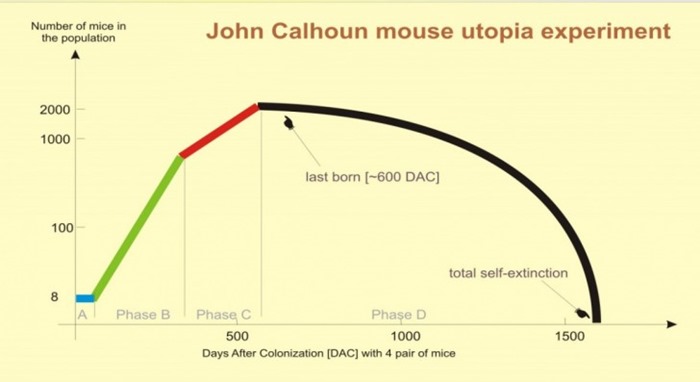
Calhoun’s rats and mice experienced a ‘demographic transition’. Sorry about that.
223. How can humans save the Earth?
A from something is implied. If from a large asteroid, then the only animal who conceivably could foresee the impact and intervene to prevent a mass extinction event that would save a portion of life on Earth is modern techno-industrialized humans. Earth itself, as third rock from the sun, is not at risk from anything mere humans could prevent, such as Sol going nova or Vogons building a new hyperspace bypass. But I assume that what is to be saved is life on Earth from serious ecological degradation and simplification.
There are potential threats (e.g. a nearby gamma ray burst), but the only known clear and present danger to life on Earth are humans living in complex societies empowered by energy exploited (e.g. fossil fuels) or diverted (e.g. agriculture) to support humans, livestock, and pets, i.e. modern techno-industrial (MTI) society. Humans living within limits, within the carrying capacity of their biome, do not need to be exterminated or otherwise depowered, but MTI society will be. It cannot but do what it is doing, which selects for its failure to persist.
How can a doctor save a patient from metastatic cancer? Maybe somehow turn the carcinogenic cells back into normal cells? Perhaps target them in some way that doesn’t also destroy too many normal cells? Surgery works, but only if all cancer cells are removed as even one left would repeat the pattern. In our case, it is the MTI superorganism that needs to be replaced with a viable form of complex society or at least prevented from metastasizing, forever.
The cancer analogy does not apply entirely in that when the cancer kills the system it is part of and depends on, the cells will all die, always. MTI humans are unlikely to destroy all life, i.e. the biosphere. We may not destroy much more than half of it (we are presiding over the greatest mass extinction since the late Cretaceous that could exceed that of the Permian) before collapse of our socio-politico-economic subsystem (i.e. our now global empire).
Likely some humans will persist in some form, which could be a form their ancestors (us) would view as a condition worse than extinction. Or perhaps some possessed of foresight intelligence could ‘vote with their feet’ and form pockets of sustainable society having the potential to become evolvable and iterate towards a viable ecolate civilization, which is my plan to ‘save the world’ (from MTI humans).
224. Will there be a time when the Earth cannot contain everyone?
Questions of human carrying capacity usually assume that carrying capacity is exceeded only when a maximum number is exceeded followed by a population collapse. This is true for plaque species, but not for K-strategists, species whose populations fluctuate at or near the carrying capacity (K) of the environment in which they reside. Our ancestors were K-strategists. We modern techno-industrialized humans are a one-off plaque species. Unlike some locusts, for example, we are not adapted to overpulsing our population, so there will be no adaptive/evolvable outcome, merely a dissipative one (e.g. hurricanes are dissipative structures that adapt to terrain but do not evolve).
What is the carrying capacity of Earth for K-strategist humans? Perhaps somewhere in the range of 7–35 million globally. Carrying Capacity, Overshoot and Sustainability
The use of technology has enabled humans to divert Earth's primary productivity (via photosynthesis) into humans, crops, livestock, and pets via converting biomes into typically unsustainable agricultural systems. Due to anual flooding (e.g. ancient Egypt), swidden methods (allow fields to lie fallow for 15-50 years), and the practice of adding 'night soil' to flooded rice paddies, some agricultural practices are sustainable, but cannot be anywhere near as productive as turning fossil fuels (directly and indirectly) into food (for a time, e.g. a 100-story vertical farm using artificial grow lights and everything else).
225. Is there any solution to the growing population?
There has yet to be any politically viable solutions and appeals to individual restraint merely select for those who refuse limits. But there could be viable solutions that are currently unthinkable to virtually all humans. For example, it may be possible for a virus to cause male and female bodies to produce antibodies that disable sperm, causing infertility. The antibody could itself be disabled by an injection that enabled fertilization (for a time, perhaps for six months). If infertility was the norm, there would be no unintended births. About half of current births are unintended.
This would reduce the current fertility rate. It would select for those who elect to be fertile, perhaps because they are paid to. Only some would take the treatment and use their state of infertility as the better form of birth control it would be. But what if the treatment was not available to all?
Maybe a billionaire (just one of some 2,755 and counting), instead of investing in space tourism, could invest in the development of a virus that had only one symptom: it caused infertility and was as (or more) easily transmitted as COVID. No one would even think to take any precautions until all humans had become infected and infertile. Only just enough infertility reversal treatments would be given each year to maintain the human population at any level the billionaire decided upon (e.g. 7–35 million). Only one lab could produce the treatment and any attempt to control it and force it to produce unlimited treatments would cause the lab to automatically self-destruct and humans would soon go extinct.
Only a small fraction of a percent of humans would vote for this solution, but it would be a solution. There are no solutions a majority of humans would vote for (or be able to force on the 49% who didn't). Something to think about.
226. You suddenly have the single solution to save mankind from the impending apocalypse. How do you convince people you aren’t full of it?
The Great Acceleration began about 1950. Those who were paying attention asked, “And then what?” Howard T. Odum was a systems ecologist who was paying attention. He was not entirely alone in seeing the single solution:
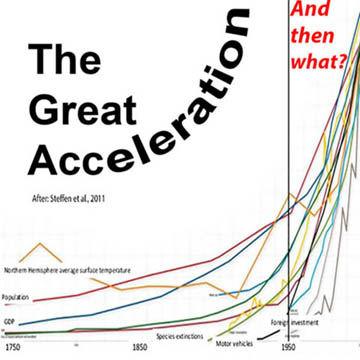
"What is the general answer? Eject economic expansionism, stop growth, use available energies for cultural conversion to steady state, seek out the condition now that will come anyway, but by our service be our biosphere's handmaiden anew." Energy, Ecology, & Economics 1973
Of course things change and stopping growth will not be enough as we are now well into overshoot and must contract about 90+ percent to be in the ballpark to transition to a steady state. Odum knew this and published before he died A Prosperous Way Down in 2001 as that would be the most we could hope for if we embraced now, better late than never, the condition that will come anyway.
He noted: "I have played many roles sometimes with the majority, but more often attempting to shock the scientific establishment into a better view."
He failed as his better view was not what the majority wanted to hear. They still don’t and my guess is they won’t until they can no longer believe in modern techno-industrial society. There may come a “teachable moment” when our capacity to deny, deny, deny collapses. When will humanity realize that Odum et al. are not full of it? When humanity realizes that the consensus view is profoundly delusional.
When that might be forced upon us is anybody’s guess. By chance, a few will claim they foresaw the moment, but the question is will anyone credible be in a position to say, “we told you so” and detail a design for a viable civilization as alternative to chaotic collapse (aka zombie apocalypse)?
Why aren’t there a hundred teams of top scientists working on designs for a viable eco-literate civilization? Oh, the denial thing. But the teachable moment cometh…., and then what? 'Chance favors the prepared mind.'
227. What is currently recognized as surrealistic technologies? If it were real, could they solve the key global problems of humanity?
Nothing surrealistic needed. A virus as easily transmitted as the Delta variant that had only one symptom: it causes infertility in humans only. The lab that manufactured it has a cure. One injection restores fertility for six months. The lab produces 350k doses per year, distributed by lottery. Any attempt to take over the lab to force it to produce unlimited doses would result in the destruction of the lab and loss of information about how to temporarily restore fertility such that within a century or so, humanity would be extinct. Either way, name one problem whose long-term solution would in any demonstrable way not be aided, assisted, or advanced by a rapid reduction in human population?
228. How did an MIT computer, using World3 System in 1973, predict that the world will end, provoked by humanity, in 2040?
World3 was a model that simulated the world system such as was possible in 1971 when the book, Limits to Growth 1972, described 12 scenarios, none of which were predictions. One ‘predicted’ a steady-state outcome, but the assumptions that had to be made were ad hoc and in the last 50 years nothing liked them has been seen. When I finished reading the book in 1972 at age 19 I realized I might still be around when our system climaxed. That it would was a prediction, but when was not predicted. I reread/skimmed the book and assume a business as usual future, guessed that climax would come somewhere between 2030 and 2070.
I read the Limits to Growth: The 30-year Update published 2004, which considered 10 scenarios and noted that for 30 years humans had followed the business as usual trajectory. My current best guess is that climax will come sometime between 2030 and 2070, though 2028 would not surprise me at all. But I predict that when climax comes, it will take at least 10 years for a majority of experts/thought leaders to realized it, such is our capacity for denial.
For two more recent updates:
Limits to Growth Updated, Harvard & Yale 2020
By the 1990s the belief that the Limits to Growth study had made predictions and that they had all been proven wrong spread among the intelligentsia because they would rather believe than know, like those they (mis)inform. The following shows over a hundred scenarios, different runs, based on randomly picking different values for variables that happened, out of over a million runs, to correctly model what is known of the last 50 years. If you wanted to turn it into some kind of prediction as to when, then pick 2028, but that would merely be an average.
What is important is that system dynamic modeling that correctly predicted the last 50 years, always show a climax and descent pattern. When the climax occurs and how fast is the descent is unknown and unknowable as complex systems are not only more complex than we know, but more than we (or any computer model) can know. Models are good guesses, likely better than uncle Fred’s or your most deeply held guess.
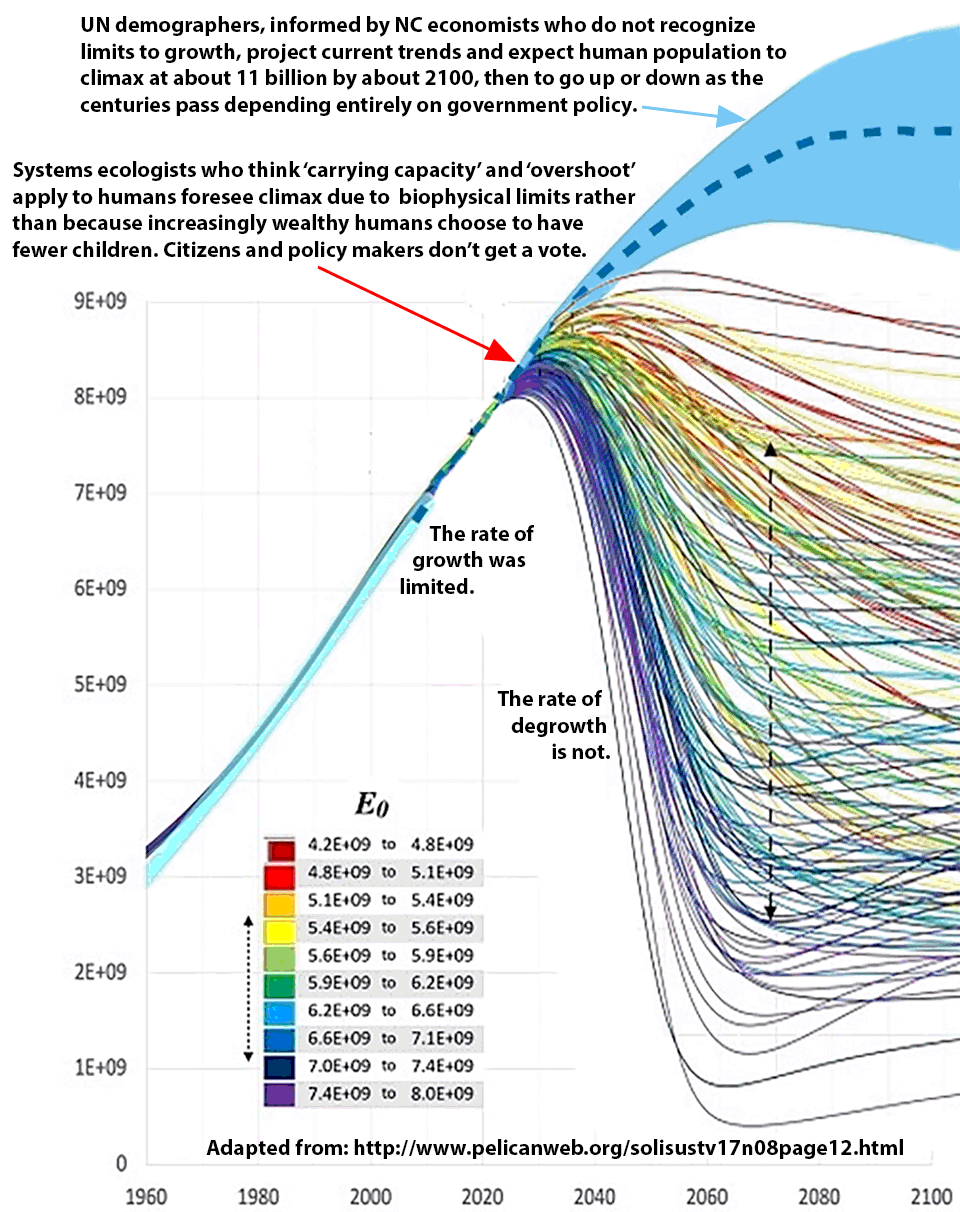
http://www.pelicanweb.org/solisustv17n08page12.html
And the world will not end in 2040 even if the Limits to Growth study had predicted it would.
Humanity is colliding with Nature.
A damaged biosphere will persist.
We humans may not be part of it.
There are no political solutions.
229. What is the very long-term future of the human race?
 Biologically, in the very long-term all species go extinct or become ancestors of new species. Humans could speciate into multiple other species, one or more of which could persist ‘long-term’ however that is defined.
Biologically, in the very long-term all species go extinct or become ancestors of new species. Humans could speciate into multiple other species, one or more of which could persist ‘long-term’ however that is defined.
Per THE BOOK, humans don’t last long enough to speciate, but they do give rise to The Inquiring Ones who, while exploring the Andromeda Galaxy, meet The Deep Ones whose merest operational parameters they are unworthy to compute, and mention that their origin had involved a bipedal ape during its clothes wearing phase.
230. What specific eras and events in our history have caused the most irreversible damage to our planet?
To mention the obvious, the specific era is the Anthropocene that we are now in and the cause of what could be the greatest mass extinction since the Permian. We seem to think that if only we can cause a greater mass extinction event than the Permian, then we win. Pathway to Humans
231. How does civilization lead to the loss of all development gained since the Earth was formed?
Civilization, aka complex society, has proven to be non-persistent, i.e. all prior empires/complex societies have collapsed, fallen, or if they take a century or so to pass into history, some prefer to say they faded away. The remnants of 18th and 19th century empires have become, have been subsumed into, the first global empire, a monetary culture committed to economic growth and expansion. All who serve it with any enthusiasm believe it will be the exception, will not incur a loss of all development, just as those who served all prior complex societies did. Consider Joseph Tainter's The Collapse of Complex Societies or the Past Lives of Humans.
Civilization is a recent development that has proven to be non-evolvable. About 3.9 billion years ago complex, adaptive and dissipative chemical systems degraded available energy gradients. Like a tornado or whirlwind/dust devil, they possessed complex structure, adapt to terrain, but they were not evolvable. A thunderstorm of today, full of sound and fury, dissipates but doses not evolve, and so would be functionally the same as one in the Jurassic. A metastatic cancer is complex, adaptive, dissipative, but not evolvable.
At some point an abiotic replicator became biotic, a complex adaptive, dissipative and evolvable system. Information was selected for and stored in the form of RNA and later DNA. Humans store information memetically and are potentially memetically evolvable, in addition to genetically, but no cultural mutations that might allow for evolvability have occurred and been selected for yet (and may never be).
Complex society, first enabled by regional high energy sources, e.g. wild grains or fisheries (and technology to exploit them), that could support long-term settlements (larger than Dunbars number, >150 max population) that selected for population growth as larger populations have a competitive advantage over smaller, weaker ones. When conflict arises, the larger army tends to win and empire building (civilization) is selected for.
Complex societies select for their own failure (so far), for the loss of all development, of all information. Genetically a species does this by going extinct (for all information to be lost, this will happen when all life on earth goes extinct). All prior information contained in the species genome is not passed on (though identical genes in other species are). A civilization does this when no literate member, or oral teaching, passes on the culture's memetic information (and misinformation). Millennia later other humans may excavate enough sites to realize that a civilization, geographically separated from the Egyptian and Mesopotamian civilizations (but more 'developed') had once existed. Numerous prior civilizations developed writing but failed to leave literate descendants (e.g. the writers of Harappa, Elamite, Minoan, Akkadian, Egyptian, Canaanite, Hittite, Phoenician, Sumerian, Olmec, Vinča, Mayan..., and Rongorongo).
The collapse of modern techno-industrial society could have the same outcome as that of the Indus Valley Civilization except being global, all prior memetic information could be lost to the wind. Some humans could survive and develop complex societies to re'peat the pattern, for a time. They may find artifacts that inform them that prior civilizations existed, just as we know Compsognathus once existed.
232. How long is the average duration of all civilizations/empires in history?
About 520 years.

As time goes on, the average lifespan decreases. If modern techno-industrial society (the Euro-Sino Empire, now global) started in 1712 with the Newcomen steam engine, then the complex society we are all products of, depend on and serve (if you have, make/spend money, then you serve the monetary system/economy as do all “sovereign” states) has lasted a bit longer than average.
Past Lives of Humans
233. What does it take to make the world a better place?
H.G. Wells outlined the state of the world, its history, in 1920 in his two volume work The Outline of History which began with the story of the formation of Earth and the development of life on Earth, but because only humans bought or read his books, he tended to focus on human social systems, aka the development of complex societies over the last 10k years. He noted that all prior civilizations/empire building societies had failed, fallen, collapsed, or faded away with much conflict, destruction, death and suffering. He noted that for near future of humans of his day, that:
'There may be tragic economic struggles, grim grapplings of race with race and class with class. We do not know; we cannot tell. These are unnecessary disasters, but they may be unavoidable disasters. Human history becomes more and more a race between education and catastrophe.... New falsities may arise and hold men in some unrighteous and fated scheme of order for a time, before they collapse amidst the misery and slaughter of generations. Yet, clumsily or smoothly, the world, it seems, progresses and will progress.... We have sketched too the gathering for a human sacrifice...: the body was bent like a bow over the curved stone of sacrifice, the breast was slashed open with a knife of obsidian, and the priest tore out the beating heart of the still living victim. The day may be close at hand when we shall no longer tear out the hearts of men, even for the sake of our national gods. Let the reader but refer to the earlier time charts we have given in this history, and he will see the true measure and transitoriness of all the conflicts, deprivations, and miseries of this present period of painful and yet hopeful change.' ― H.G. Wells, The Outline of History (1920) vol. 2, ch. 41, pt. 4
Wells was well aware that the world humans have been busy making over the last 10k years was ‘doouble plus ungood’ as George Orwell might say. He, and other intellectuals of his day, wondered how to make humans better such that they might come to understand the planet and learn to live with it and one another properly, i.e. without destroying the planetary life-support system and the complex societies they lived in and depended on.
In 1933 he published his thoughts in the form of science fiction view of a possible future. Aldous Huxley had already published his Brave New World in 1932 and George Orwell would add his 1984 vision of our future published in 1949 to complete the trilogy of humanity’s best guess about the future we live in. Wells’ vision went to 2106 and of the three books, has been curiously neglected as we have failed to win or even make progress in our race between education and catastrophe.
Huxley’s offering was alarming as it ‘had such people in it’ not unlike we have increasing become, and Orwell’s vision was prescient too as Stalin and others were to prove, but only Wells envisioned a ‘period of painful and yet hopeful change.'
To make the world of, by, and for humans better he envisioned some humans re-envisioning their place in the universe, learning to live with it properly, and then educating the multitudes to think, feel, and behave differently to create ‘a new world order’ that many of us now fear. He noted that ‘The existence of independent sovereign states IS war’, and that all organized religions work to support sovereign states. He envisioned an end to both.
Wells’ book, The Shape of Things to Come, envisioned WWII as starting a few months after it actually did, so he was wrong about that and many other details, such as guessing WWII would last much longer than it did. He envisioned a coming plague, but it killed about half of humanity, as the Black Plague had, instead of a few percent. But, after just a century and a half of pain and struggle, humans become re-educated to live properly with the planet, maintaining their population well under a population of 2000 million. By 2100, humans had entered the Era of the Modern State (one) and were likely to live long and proper as the millennia passed. Making the world a better place involves making modern techno-industrialized humans better educated, the opposite of what we are doing.
234. What is the appropriate term which refers to a society which has achieved a state of civilization, or an advanced such stage: 'civilised' or 'civilizated'?
People who think they live in a civilization or are civilized are also products of, dependent on, and so sing the consensus song that civilization (especially theirs) is a great or at least good thing. If your society is being conquered by civilization as usual (for your own good of course), then the civilized may be indistinguishable from the Great Satan. A more appropriate term less likely to be colorized by one’s amygdala, for or against, is ‘complex society’.
Societies that exceed Dunbar’s number (>150) select for hierarchy and overcomplexity/stress that humans have yet to make work. The Siane of New Guinea have learned to make living in populations of about 250 work long-term, but few others have.
Chiefdom level complex societies numbered in the thousands for millennia before involuntarily consolidating their franchises. Large chiefdoms similarly develop into fewer but larger chiefdoms, some of which become small empires that also come and go (have proven unsustainable). Some regions support, for a time, city-states, and large empires (aka civilizations) include more than one former city-state whose resistance to being truly civilized proved futile.
The largest civilization/empire is the one all who can read this and 99+% who can’t live in. It is appropriately to be thought of as the first global complex society/economy (modern techno-industrial monetary culture) empowered by fossil fuels to have formed and likely the last global empire to form as supporting a global empire empowered by wind, water, and agriculture may not be possible.
235. If you believe Western civilization's downfall is taking place, when would you say this downfall has started? Who are some people who predicted this?
100+ answers, so briefly: downfall has not quite started as we of the Euro-Sino Empire have not yet peaked or climaxed in our 350 years of growth to then decline, collapse, descend, or fade away. A notable person who foresaw climax and descent was H.G. Wells in his 1933 book, The Shape of Things to Come.
Degrowth was locked into the system when we blew past global long term carrying capacity. Some experts would argue that we went into overshoot about 1970. But that implies Earth could sustainably support 3.7 billion humans (the population in 1970). Actually, the best guess of ‘those who know enough to have an opinion’ (e.g. systems ecologists, population biologists) is in the 50 million to 2 billion range. One economist thinks Earth can sustainably support 1 trillion, so I guess you can believe anything you want, and most do.
A more objective view than most humans can tolerate claims that we K-strategists went into overshoot when our global population exceeded 7 to 35 million 3k to 4k years ago.
Carrying Capacity and Overshoot
236. How do we responsibly address world population growth? How do we help the population the Earth has already? How many human beings can the Earth sustain?
How do we responsibly address world population growth?
By rapidly degrowing the human population. By ‘rapidly’ think 50 years. How to do so may involve doing more than educating and empowering women, spreading pollutants that decrease fertility (e.g. sperm count) or increasing stress levels that reduce fertility via loss of functional behaviors (GAS and Calhoun’s ‘behavioral sink). Any ‘how’ must involve a rapid birth-off.

How do we help the population the Earth has already?
Both the existing human population and Earth’s planetary life-support system (all other life on Earth except livestock, pets, crops), aka biosphere or environment, will be maximally helped by rapidly degrowing human population.

How many human beings can the Earth sustain?
This is the key question as it would be the human population after rapid depopulation of the planet of humans, livestock, pets, crops and contraction of industrial/urban sprawl/pollution (reducing human population automatically reduces that of our mutualists/footprint). What is the sustainable human population Earth can support (not including Mars or space habitats)? You could ask the experts:

Cited by authoritative BBC article in 2016.
The high estimates are by economists who believe in illimitable growth and who call for policies to encourage population growth to continue well past a mere 11 billion. You need to pick your experts and believe in their ignorance (and your own). There are much lower estimates than 2 billion. The UN chose to exclude them. One ecologist asked colleagues (about 60) judged to know enough to have an opinion via confidential email what they thought the maximum sustainable population of humans Earth could support might be. Answers ranged from 50 million to 2,000 million.
Ask a stupid question, and.... The question should be what is the optimal (not maximal) human population on Earth to maximize empower (MPP) for all life on Earth? For eons our ancestors lived as K-strategists bumping up against the regional biome's carrying capacity. Global human population was less than 10 million, think 5 million, before significant animal/crop agriculture developed about 12k years ago.
Agriculture empowered humans to become a one-off invasive species. For a time, over the last 12k years, we have been able to pulse our population regionally, unsustainably, into overshoot which is followed by collapse/descent (e.g. locust swarming or initial growth of an invasive species). For over 300 years we have been using fossil fuel energy slaves and have learned to turn vast amounts of fossil fuels into food. Virtually all of the food production systems currently marginally supporting 8 billion humans is unsustainable (i.e. all using fossil fuel inputs, all where the soil erosion rate exceeds soil formation rate, all that mine soils for macro and micro nutrients faster than released from parent material, all that involve increasing soil salinization such as by irrigation).
The question boils down to what population of humans on the planet would not cause species extinction nor prevent the evolution of new species to replace those humans have already caused? To get the answer, don't ask human experts, instead, ask Nature who has all the answers. Assuming low-intensity agriculture, a global population of more than 5 million could likely be supported without causing loss of biodiversity (exceeding carrying capacity). The range of optimal human population is likely somewhere between 7 million and 35 million. See: Carrying Capacity, Overshoot, and Sustainability.
Will 51 percent of humans agree to a rapid birth-off (to avoid a die-off) and force the 49 percent to go along? Probably not, so, as Nature is unkind, I expect that descent will be involuntary and unmanaged (chaotic) as usual. Humans will resist descent and growth may resume for a time (to further degrade the planetary life-support system), but eventually the human population will degrow and perhaps humans will learn to understand and live properly (the hard way) with the planet. Or we can go extinct. No one knows or can know our fate. The only certainty is that growth will climax. When and then what is not foreseeable. Sorry about that.

237. What would be the most humane yet effective way to reduce over population?
To reduce human population humanely to a sustainable population within the carrying capacity of the planet (one that does not cause species extinction or loss of potential biodiversity), i.e. to a population likely to be in a range of 7 to 35 million, we would need to do so rapidly (<50 years) to avoid a die-off. Any effective and humane (which excludes chaotic but effective die-off) rapid depopulation could be called a birth-off (to avoid die-off). This would/could be achieved if initially 1 in 200 women who wanted to give birth did and in 50 years the average woman gave birth to 2.1 children.
This could not be done by policy or decree, i.e. there are no political solutions. No democracy would/could even try it, and no autocracy would self-select out (allow others to conquer them) by trying it (e.g. China). If a rapid die-off is the alternative, then a rapid birth-off would have to be achieved through some other means than force or appeals to choice.
A hypothetical solution would be a virus, more infectious than the Delta variant, that had only one symptom: it caused universal infertility in humans (male and female perhaps by creating an antibody that immobilizes sperm, including viable sperm once within a female body). If there were no treatment, then all humans would humanely die a natural death, insofar as possible, before our species goes extinct.
But assume 25 million humans could live properly on the planet (without causing extinction of other species) if they properly understood it and how to live with it. Assume the virus was designed to cause infertility and the designer had a treatment that involved an injection. The injection disables the antibody all humans now produce for six months. Both a male and female would have to be injected (or one male and ten or so females would work), but the number of females injected was effectively limited to the number of female doses produced each year.
Assume only one laboratory can produce the treatment and that no humans currently know how to produce the cure. The lab is run by AI and any successful attempt to take over the lab by humans would result in its auto-destruction (and human extinction).
To maintain a population of 25 million would require about 360,000 births per year, or 30,000 per month or 1,000 babies born everyday. Initially there would be about 8 billion humans to care and provide for them. Perhaps their care, development, and education would become the highest priority imaginable (instead of growth of the economy).
In about 50 years 1,000 babies a day would still be born. Some woman would have no children, some might have ten, but on average each has 2.1 children (some die as children or before reproducing). Only those wanting children would have any, and so wanting children would be selected for (as it always has been), but no one got as many as they wanted (as has always been the case before humans became an invasive species).
Life for 25 million humans would not have to be a mean, nasty, brutish, and short one, just limited in total population as limited by the environmental productivity of the biome within which a community of humans lives, pretty much like all of our K-strategist ancestors going back eons lived. Life could be worse (and you are living it).
Carrying Capacity and Overshoot apply to those humans who are also evolvable.
Oh, but what if a billionaire doesn’t fund the development of an infertility virus or other solution that could actually result in a rapid contraction of humans and their current enterprises? Hypothetically, those who were willing to forgo their ‘right’ to reproduce at will (the 0.001% to 0.1%) could vote with their feet to form pockets of sustainable and viable society that hypothetically could pass through the coming bottleneck to establish a new world order after those who don’t/won’t/can’t crash into biophysical limits (and die-off as usual).
Or not and we go extinct. Or after maybe 500 to 1,000 years of environmental restoration, remnant populations repeats the pattern of regional empire building, overpulsing and collapse, until they can’t. Humanity is now playing a high-stakes endgame (badly, non-viably).
Any narrative of what a viable civilization might look like or how one might come about is unthinkable to the 99.9% to 99.999% of modern techno-industrialized humans who will not like the story. Sorry about that.

238. Why does everyone think overpopulation is a really terrible thing?
If we are in a condition of 'over' population, it is because of growth, and growth is the best thing that could happen, for a time, whether you’re a bacterium, archaean, or eukaryote (or even a virus). Ask any human fertilized ovum (if it lives long enough, but not long enough to come to believe in degrowth) how it feels about growth.
I’m a growther and a degrowther, but I don’t believe in either as I don’t believe in belief. I do notice that any living organism that remains evolvable is selected for if it also adapts (not by choosing to as choice has nothing to do with it). Is it good to persist as an individual or species? I don’t know.
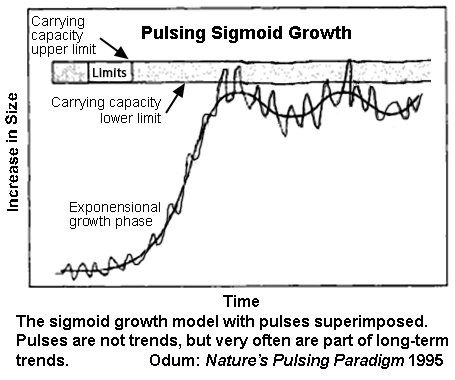 Those who behave as if growth were a good thing tend to follow an r or K reproductive strategy. Humans are K-strategists, but not because I say so. For eons our ancestors bumped up against our local/regional biome/environment, but were selected against if they exceeded K (carrying capacity). All us K-strategists grow our population and per capita consumption whenever possible. In good times we get fat and if good times persist (for a time), e.g. if for 42 years there is above average rainfall, then we have more offspring and more survive, for a time. There is always the one-hundred-year drought (by definition).
Those who behave as if growth were a good thing tend to follow an r or K reproductive strategy. Humans are K-strategists, but not because I say so. For eons our ancestors bumped up against our local/regional biome/environment, but were selected against if they exceeded K (carrying capacity). All us K-strategists grow our population and per capita consumption whenever possible. In good times we get fat and if good times persist (for a time), e.g. if for 42 years there is above average rainfall, then we have more offspring and more survive, for a time. There is always the one-hundred-year drought (by definition).
Growth may be the best thing ever. But there is always the qualifier, 'for a time'. Collapse, descent, decline, fading away..., degrowth has always seemed lamentable to those living through it. The downslope always seems double plus ungood to those treading it, for a time, but it could be the precondition for new mutations to arise, sweet, arise.
So, is growth good? Always. Is managing to not overpluse into overshoot, living within limits, good? Always, at least from the biased POV of an individual or species. Can humans, in the form of Modern Techno-Industrial (MTI) society (aka civilization, a complex, adaptive, dissipative but not as yet evolvable structure) live within limits? No, not merely because we haven't, but because we can't, not in the form of the MIT society/monetary culture we are all products of and serve. If we were (could?) become sapient (form a psychospere of memes that selected for sapience), we upright bipeds hypothetically could, but not as modern techno-industrialized humans. Sorry about that.
Our best and brightest are beginning to tell a consensus narrative of overshoot and pending collapse. The lowest number of humans the planet can sustainably support is said to be about 2 billion by those members of the intelligentsia who want to continue to be members, to be considered thought leaders who might save the world if the public (and policy makers/leaders) listen to them. They agree that humanity went into overshoot about 1970 when there were 3.7 billion humans on the planet. None seem to notice that 2 billion (exceeded in 1927) is less than 3.7 billion. But it gets worse. Leading human ecologists agree that causing species extinction involves degrading the carrying capacity of a biome (via overshoot) or planet, but that overshoot is a recent, twentieth century thing.
Modern techno-industrial humans are currently causing over a 1,000 fold increase in the rate of species extinctions on a pathway towards causing a 10,000 fold increase by the end of the 21st century. We are presiding over a mass extinction event that could rival that of the Permian. We did not start causing significant species extinction in 1970, but more like 3k to 4k years ago when most humans were living within complex societies who maximally exploited environmental productivity (including nearby humans) as a resource for the taking to support empire building as one-off invasive technology-enabled dissipative (adaptive but non-evolvable) structures.
Regionally, humans began causing extinctions when our population was in the 7 to 35 million range. So ‘ideal’, from the POV of all other life on the planet (with possible exception of some livestock and pets), humans would need to rapidly (<50 years) degrow their population to 7 to 35 million to live in harmony with the natural world, aka life on Earth. Will we tweak the MTI system into its opposite? No. Sorry about that in advance.
Can we Homo narrators come to tell better stories? Are we, despite 12k years of empire building, exploitation, and growth for its own sake (that selects against foresight intelligence), yet a most promising species? Is memetic evolution possible? Perhaps, if a mutant form arises from its dogmatic slumbers (and was selected for) that understood the planet as system and self as a subsystem of subsystems, a being darkly wise who listens to Nature who has all the answers and thereby learns to live properly with it? I don't know, and you don't either. We are all products of the MTI educational system. Sorry about that.
239. Do we live in a dystopian world in 2021?
Yes. But if we did not start living in a dystopian world of our making in 2020, then when did we? Consider the perspective of independent scientist James Lovelock who endeavors to listen to Nature (Gaia) who has all the answers: "...eventually we'll have a human on the planet that really does understand it and can live with it properly. That's the source of my optimism." [ref]
We modern techno-industrial humans do not understand the planetary system and we fail to live with it properly. If you think we (you) understand the biosphere and live with it properly, i.e. sustainably, then you haven't been paying attention and know next to nothing about the last 12k years of human history, i.e. the past (to present) lives of humans. (you are living in a state of shared error, ignorance, and illusion that has been normalized)
But then you/we are all products of the modern schooling system and the schoolers who believe themselves to be educators. Truth be told, as Isaac Asimov sometimes rose to the challenge, "Self-education is, I firmly believe, the only kind of education there is." Full STOP. Like Mark Twain, he never let his schooling interfere with his lifelong education. Those who are paid to teach are all products in good standing with the modern techno-industrial serving schooling system. Those who sing Panglossian tales (e.g. neo-classical economists, Steven Pinker, eco-modernists, political leaders who win) are in especially good standing.
So when did humanity start to live dysfunctional lives? When the first person did is of less interest than when did most humans (>50%) start living in dystopian complex societies, dystopian as evidenced by none being able to persist?

There is some wiggle room in answering given the severe limits of our knowledge, but most humans were living like their ancestors had (as viable, evolvable K-strategists for hundreds of thousands of years) until about 3k to 4k years ago when the total human population of the planet exceeded about 35 million. Living, for a time, in overcomplex, overdensity, overly stressed conditions was normalized millennia ago, hence we think the pathogenic condition and lives we muddle through are normal. The better schooled you are, the greater your certainty is that humans a exemplary specimens of life on Earth who merit their dominionism. Ask any priest or neo-classical economist with a PhD. Are there any humans who are not human centric? You've probably never met one, and if you did, you are probably an anthropologist or illegal logger and you don't speak their language.
240. Does population decrease pose a bigger threat to humans than population increase?
If the human population were to degrow at a steady rate of 1% per year, there would be half as many humans in 70 years and in 30 lifetimes humans would be extinct. Life on Earth, and the planetary life-support system, would begin to recover and in perhaps 10 to 20 million years, biodiversity would be restored. Or if we could degrow our population at just 1% for 8 lifetimes, humans could live prosperous lives of enough as the millennia and eons past to themselves evolve into forms most beautiful and most wonderful.
But we have not been sapient, and so the necessary degrowth will likely have to be over one or two lifetimes. Sorry about that, posterity. The chaotic degrowth could well result in a vast loss of information (memetic), i.e. no literate, numerate, nor ecolate humans, as usual, may survive the rapid unmanaged descent/contraction.
If the current population growth rate of 1.05% could be sustained for 70 years, then there would be 16 billion humans on the planet in 70 years and the rate of species extinction (excluding humans, livestock, crops, and pets) would be 10,000 times the pre-Anthropocene norm. But the ‘if’ is actually a big ‘IF’ as in about the size of Olympus Mons.
I recall 1970 when people were talking about ‘the environment’ much like they are talking about ‘the climate’ today. Meanwhile, the pace of planetary destruction did not and will not slow. We will keep on keeping on until we can’t, which is likely to come sooner than most people imagine (this century). We are all products of a failed educational system.
It is entirely possible to graduate with highest honors from a top university ...
241. Were there ever any eras in which humanity actually regressed or had significant losses in advancements or intelligence/knowledge?
From the POV of our ancestors, e.g. those who avoided extinction for the last 300,000 years, we modern humans have, in just a few thousand years, lost all sapience and live lives of quiet desperation, mayhem, the starkest madness and regional overshoot unto collapse (of our overcomplex societies/empires) to then partially recover to repeat the pattern. Welcome to the Anthropocene we moderns live in (for a time) and to our hyper-modern ideocracy we clever apes have instituted among us, whose schooling system we are all products of. Past Lives of Humans
It is entirely possible to graduate with highest honors from a top university ...
242. What would be the main cause of the lack of material prosperity in the lives of most people in the world?
Economists (conventional, not biophysical or ecological) think of lack in terms of a shortage of supply, solved by increasing production/extraction. This can work, but only for a time (e.g. the last 300 years of modern techno-industrial growth).
A systems ecologist views lack as a longage of demand, solved by reducing consumers or per capita consumption. The reindeer on St. Mathew’s Island had a longage of demand problem. We modern techno-industrialized humans have a longage of demand problem, i.e. an overshoot problem. Sorry about that.
It is entirely possible to graduate with highest honors from a top university and know essentially nothing about overshoot, carrying capacity, or sustainability....
243. What invention was the biggest step backwards to the human race?
As H.G. Wells noted, “Every time I see an adult on a bicycle, I no longer despair for the future of the human race.” Wells seems to have had existential concerns for humanity if not the biosphere.
The 1890s was the golden age of the bicycle. Then came the great decline at high speed.
"The worst mistake in modern civilization is allowing excess automobile horsepower.... That is, we run cars and build throughways instead of asking what is the most appropriate transportation to make an optimal fit of people and environment." —H.T. Odum, systems ecologist, interview , 2001
244. Has advancements in technology progressed with humanity? Can it change who and what we are?
A case can be made that technology has advanced, and no extraordinary claims are needed. To think that humanity has progressed, however, can only be entertained by modern techno-industrialized humans. That our loss of functional behaviors, including verbal/cognitive, is in proportion to the complexity of our society, is not mentioned by our MTI (modern techno-industrial) schooling system. Our collective hubris is a mass Dunning-Kruger effect: the more we think ourselves superior to our ancestors, the less reason and evidence there is to think so.
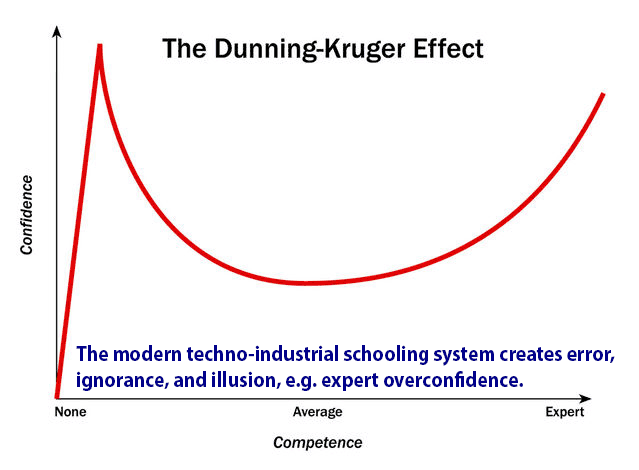
"Science is the belief in the ignorance of experts." From the speech, "What is Science?" given by Richard Feynman at the fifteenth annual meeting of the National Science Teachers Association in 1966.
The more letters after one’s name the more most experts overrate their ability to know anything. But this is an artifact of our MTI society. If true knowledge is to know what you maybe sort of know and why your best guess should maybe be considered (and more importantly, what you don’t know), then repeating what you think may have value. A truly hyper-intelligent (if not pan-dimensional) dog would be one who knew he didn’t know much about calculus (i.e. anything).
In a society of the sane, those who maybe know something, such as how to iterate towards knowing, plot out like this:
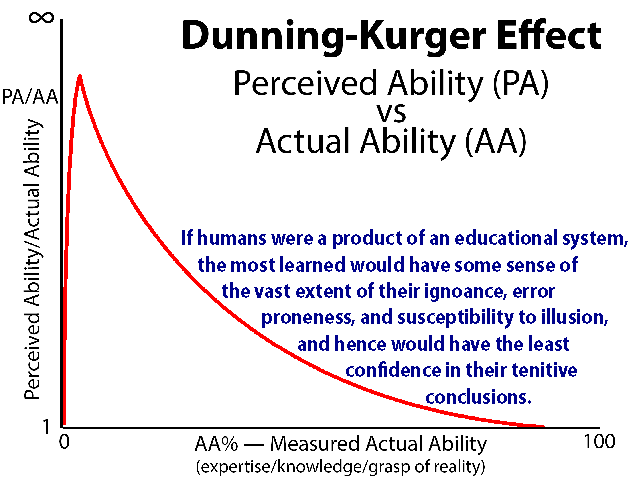
That is, the more you actually know, the less you think you know.
'He who knows does not speak, he who speaks does not know. Who knows this knowledge without knowing?' —Zhuangzi
'Knowing that you do not know is the best. Not knowing that you do not know is an illness.... True words are not pleasing. Pleasing words are not true. Those who are right do not argue. Those who argue are not right. Those who know are not learned. Those who are learned do not know.' — Laozi
'I believe I know....' — MTI hu-man (hubris-man)
Much as dogs don’t understand calculus, hu-mans don’t understand the 4th law of energetics (or the 1st, 2nd, …). and few are able to consider the possibility that decoupling from Nature is impossible, as is the well known fact that the ideas of overshoot and carrying capacity only apply to mere animals.
It is entirely possible to graduate with highest honors from a top university and know essentially nothing about overshoot, carrying capacity, or sustainability,...
245. What is Sustainable Development Goal 1?
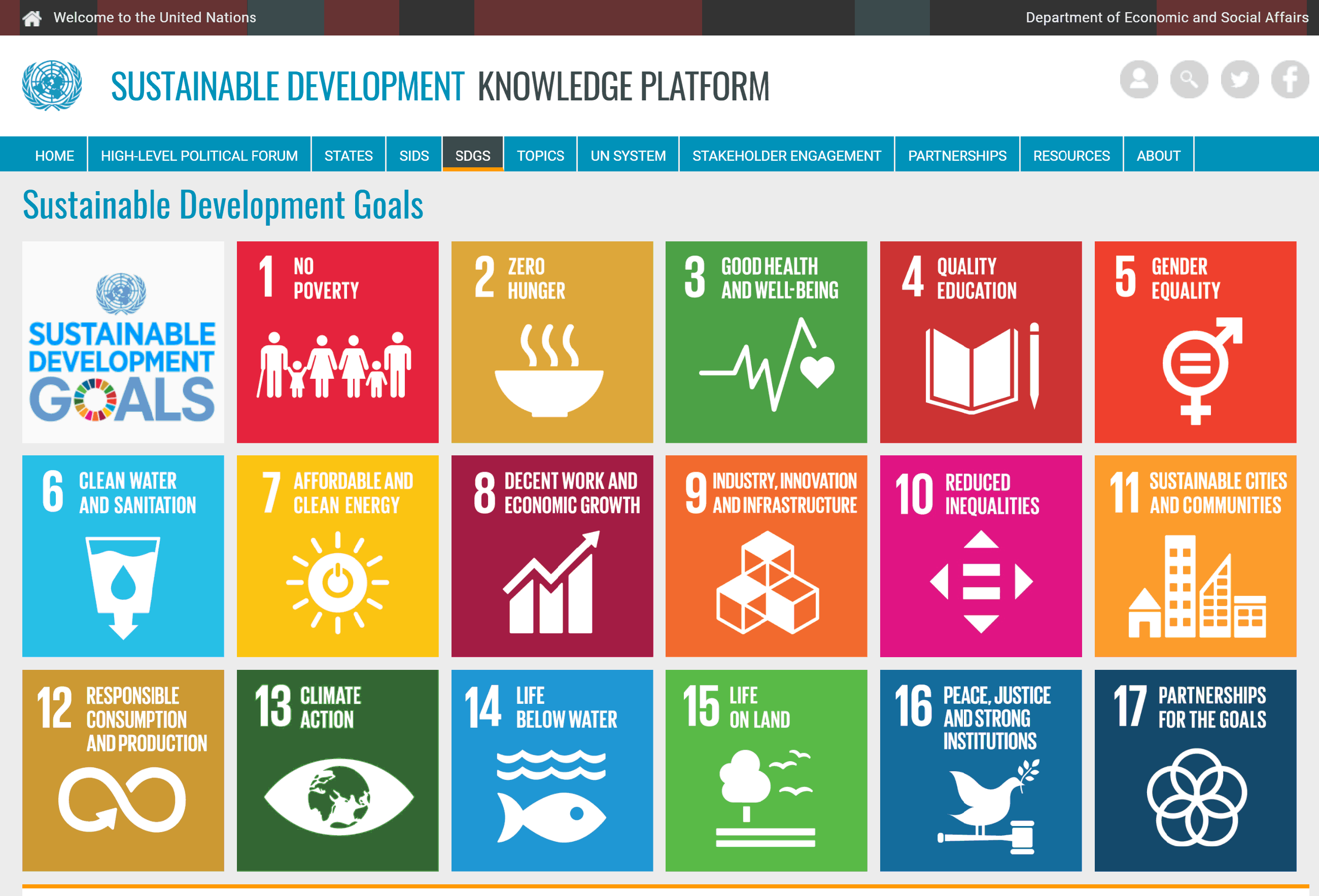
Everybody likes the idea of ending poverty. As all conventional economists know (and biophysical/ecological economists don’t) the only way to end poverty is by increasing the rate of economic growth so it will always be higher than population growth (see SDG 8). When the meta-goal of ‘sustainable development’ was agreed to in 1987, everyone agreed that the global economy should grow at 5 percent (doubling every 14 years) so even poor people would get richer and all could buy washing machines. Does anyone not like sustainable development (except systems ecologists and other know-nothings)?
Compare above to the sustainable degrowth goals:

None of these feel good, no one would except eco-fascists would vote for them. Eloquent UN wordsmiths would never propose any goal that didn’t feel good even if each one selects for the failure of the system long term. What does it matter if the descent goals would select for a viable and evolvable civilization able to persist as the millennia turn into eons? If today’s consumers don’t like something, then it is unsellable, so why even mention stupid eco-fascist goals?
No reason. Sorry. Have a prosperous Anthropocene.
246. Are we close to hitting a technological wall we will never overcome?
A Clovis point on the end of a spear hurled by an atlatl is a force multiplier allowing the tiny energy of a human throwing arm to kill a mastodon (and drive them to extinction). We modern techno-industrialized humans are not technology blind, but we are energy blind. Without the energy of the throwing arm a Clovis point is a museum piece or still embedded in a soil layer. Without fuel (an energy source, including electric), all cars will become lawn ornaments (a few might become museum pieces).
We live in a fossil fueled world and all alt energy sources, other than solar in the form of light/heat, wind, and flowing water, is made using fossil fuels. No hydroelectric dam has ever been made using hydroelectricity. Ditto nuclear, solar PV, wind turbines, or turning food/biomass into biofuels. Wood is a renewable energy source, but chainsaws, trucks, and lumber mills powered only by current solar based energy flows will at best do a fraction (maybe 10%) of the work todays energy slaves do.
We are close to hitting a wall of biophysical limits. All extraction of fossil fuels, and most mined materials including the mining of soil nutrients for crop growth, is unsustainable.
The Mining of Minerals and the Limits to Growth
Many get that we are dependent on technology, but cluelessly unaware of our absolute dependence on energy as pre-condition for continuing, for a time, to unsustainably extract and produce almost everything else, without which the global economy and population of humans will contract, and not by a few percent before growth resumes. Degrowth could be closer to 80–90 percent in the coming century with climax coming in a decade or three.

247. Which date should we go to find humanity living a lifestyle that wouldn't cause global warming and a mass extinction if we had a time machine? Any educated guesses are welcome.
The lifestyle that is now causing global warming and mass extinction started about 11k years ago with early empire building at Göbekli Tepe.
But it wasn’t until 3k-4k years ago that a majority of humans were living in complex societies. The global population was about 35 million humans. This was enough to begin causing significant species extinction. Global warming took until a planetary larder of fossil fuels began to be used in the 18th century.
Carrying Capacity and Overshoot
So if you go back four thousand years to a random location, you’d have about a 50/50 chance of being among non-empire building humans. But to avoid finding yourself among empire builders, go back 12k+ years.
248. What is the most realistic and plausible future?
Pick one.

But you don’t get a choice. Your vote doesn't count. Nature doesn’t pick the one you want.

Sorry about that.
249. What are the odds of the world ending in the next 50 years or so?
From the world’s POV we are pathetic clothed apes who think Gaia belongs to us. We are on a collision course with Nature. A damaged nature of things, the biosphere, will persist. Humans may not.
Fifty years ago the World3 model simulated different scenarios for the future of modern techno-industrial society (aka "the world"). The only prediction was that growth could not keep on keeping on, that there were limits to growth. When the system would peak and how fast the descent will be cannot be predicted in any detail. The way up was, and for a time will be, non-chaotic. After climax, the way down, whether prosperous/managed or catastrophic, is unknown. But that there will be a climax and way down is predictable.

And if you want to guess a likely time of peak everything, 2030 to 2070 is within 50 years. In fifty years will there still be places to go where you can put money (if you have any) in slot machines and watch naked women dance for you? Maybe. Or maybe modern techno-industrial society and its monetary culture will be replaced by something else. Climax will be the end of growth (and life as consumers know it), but it will be the beginning of “interesting times”.

So, know next to nothing about carrying capacity, overshoot, or limits to growth? Congratulations, you are a product of the modern techno-industrial empire’s ‘education’ (actually schooling) system.
It is entirely possible to graduate with highest honors with a PhD from a top university and know essentially nothing about overshoot, carrying capacity, or sustainability....
250. What can humanity do to counteract the increasing world temperatures?
As I type there are 42 answers. The 42nd is not the answer to life, the universe or anything. So, I will repeat the answer of the Ecolate Party as all other parties have no viable answer.
We must contract the human footprint rapidly, yet to be politically viable, no one dies a Malthusian death insofar as possible. So the human population must rapidly degrow faster than, or at the same rate as, the economy. This can be achieved by a rapid birth-off over a 50 year period. At the end of this period the initial target population will be 35 million. The need for a further reduction will be assessed at that time. The question will be, are there still too many people consuming too much environmental resources to prevent further species extinction or prevent new species from evolving to replace the loss of biodiversity incurred during the Anthropocene mass extinction event?

When the Ecolate Party is in power, it will end all political parties, including itself. This will end business as usual. Until then, the pace of planetary destruction will not slow.
Ecolate Party Platform
